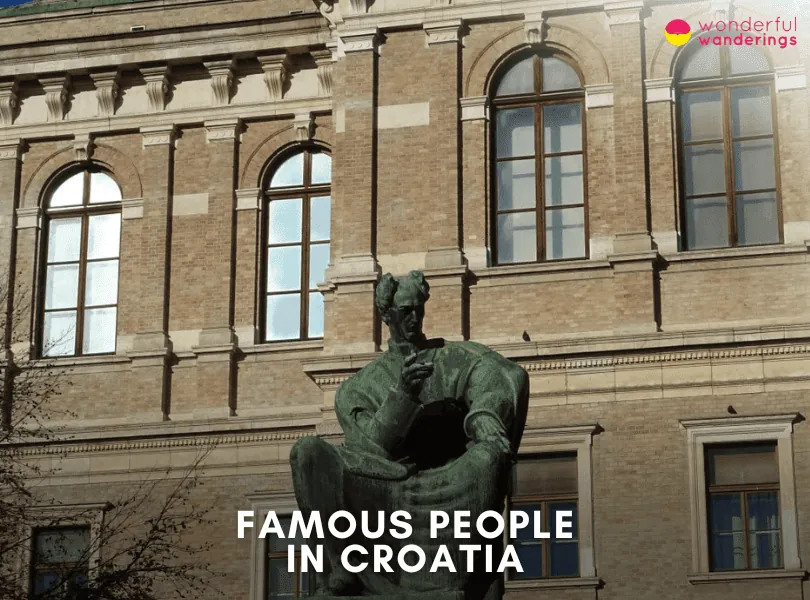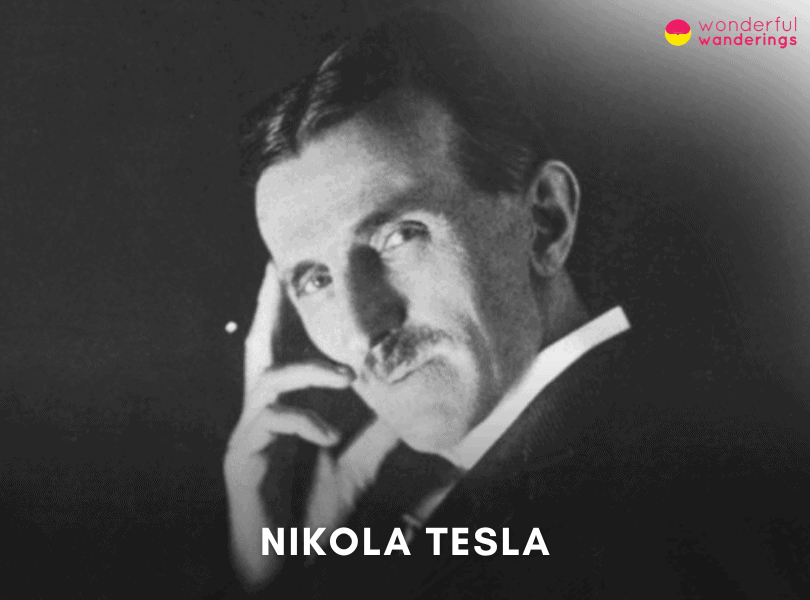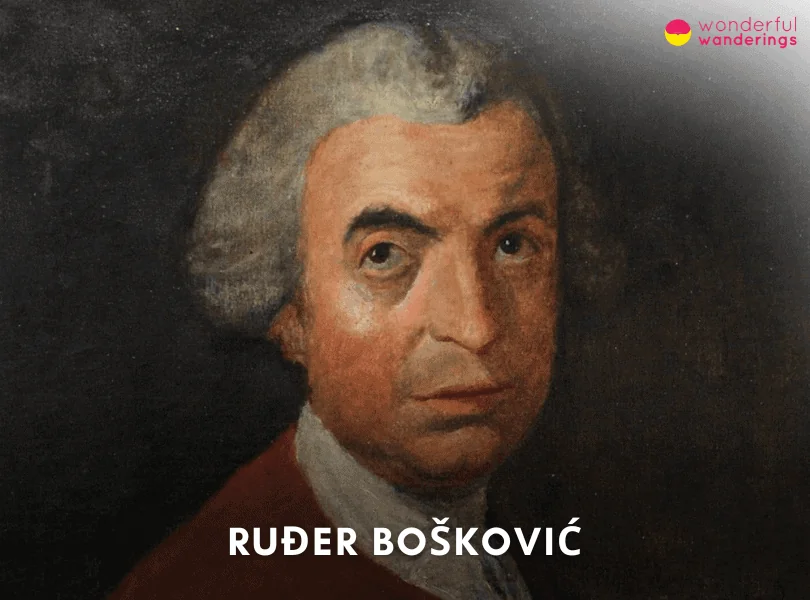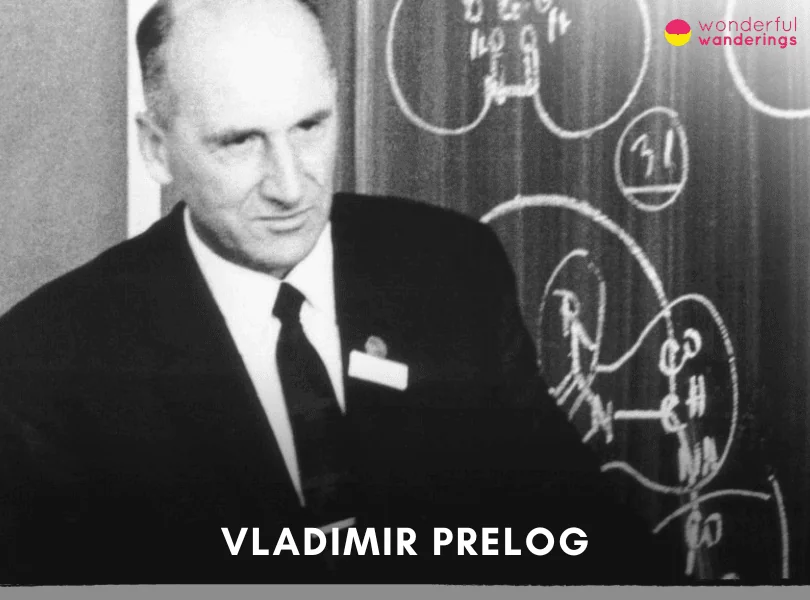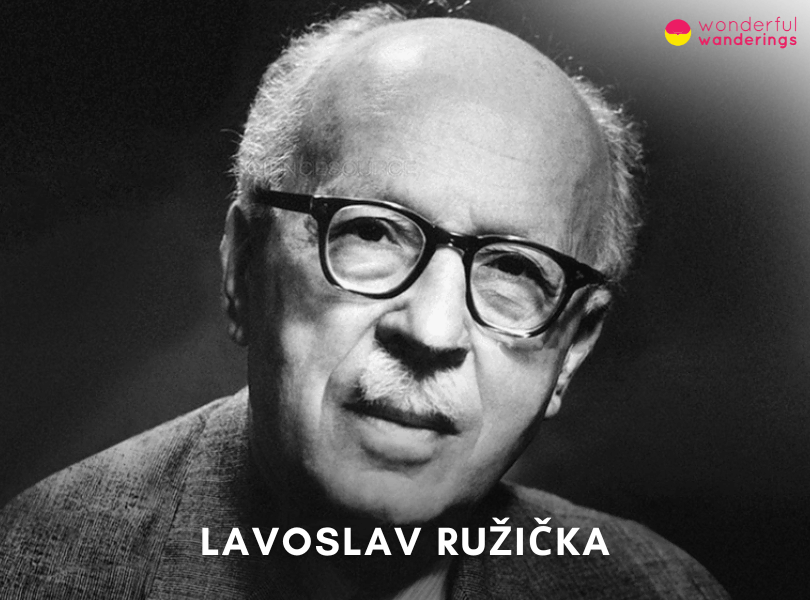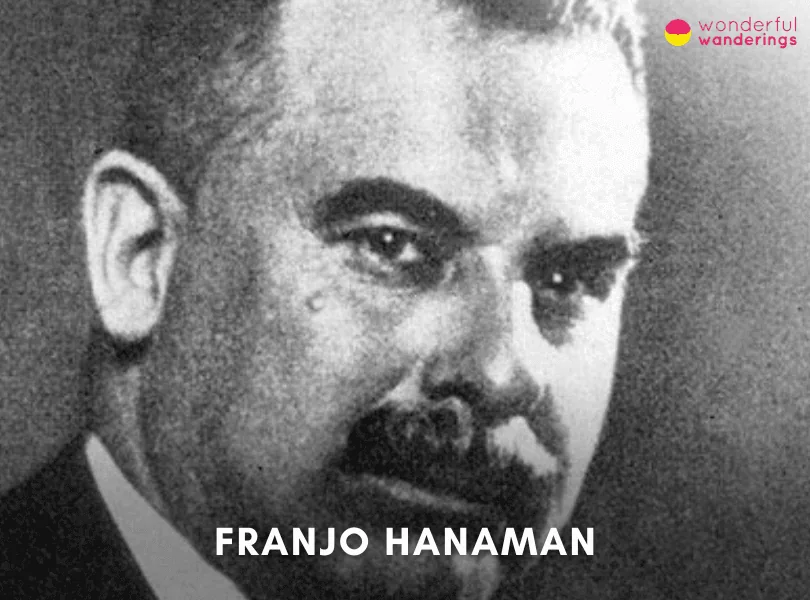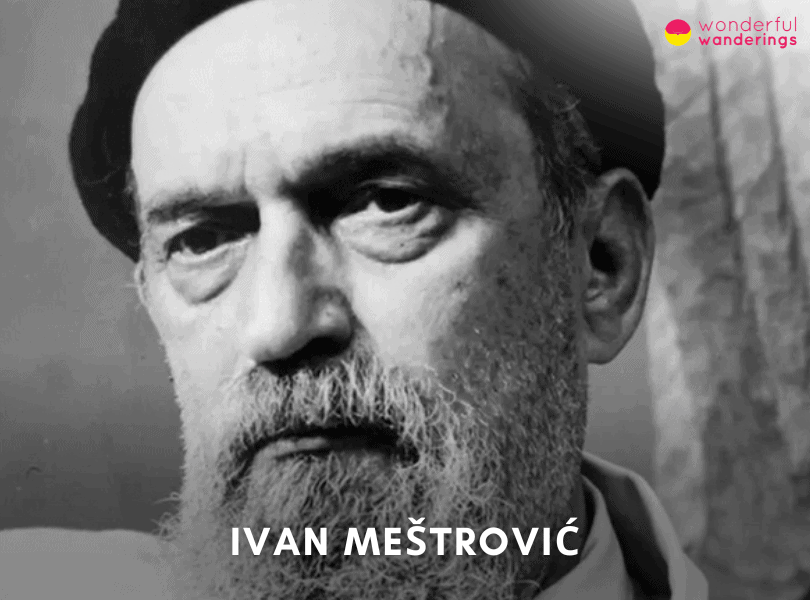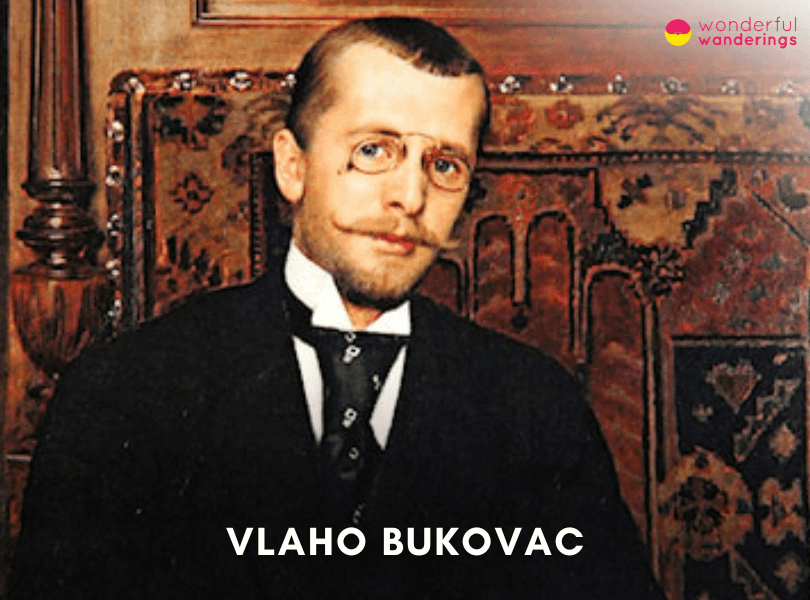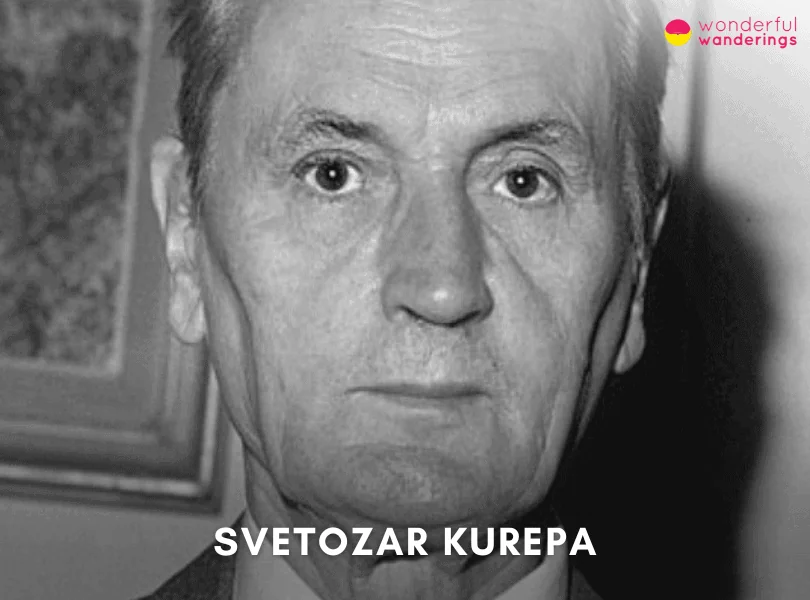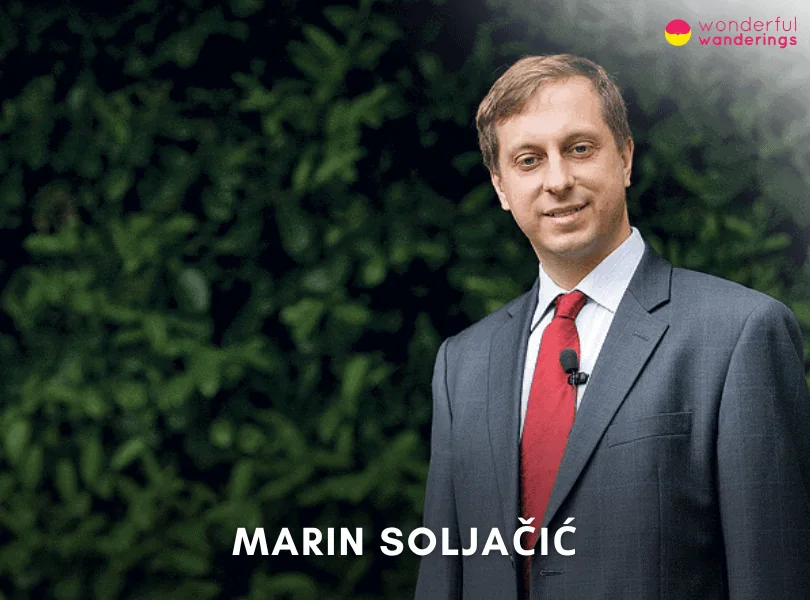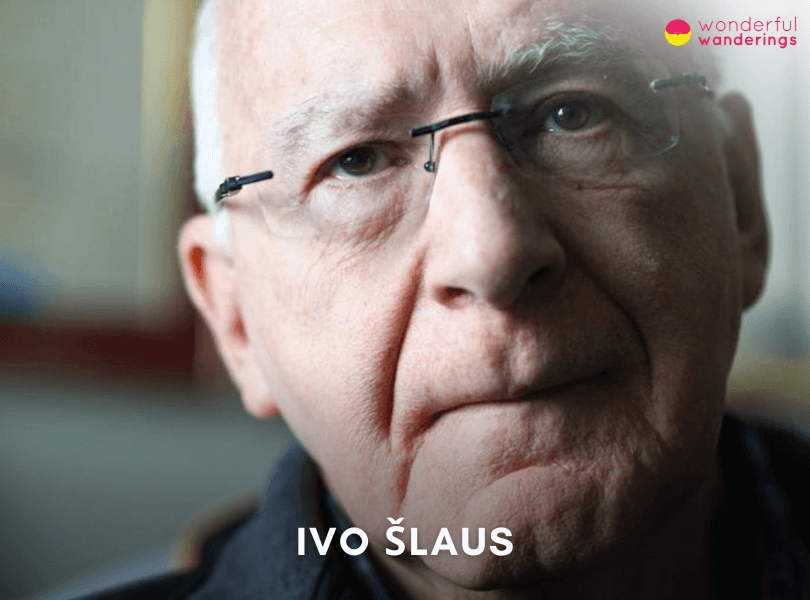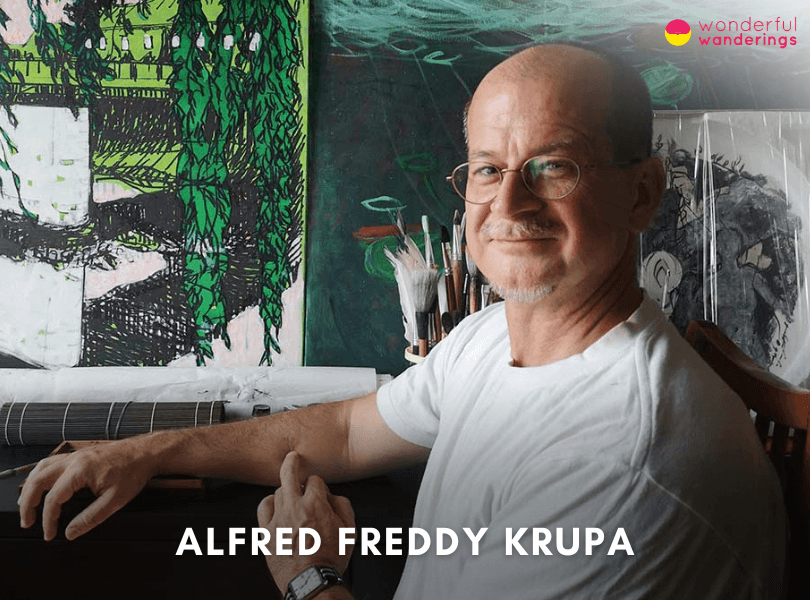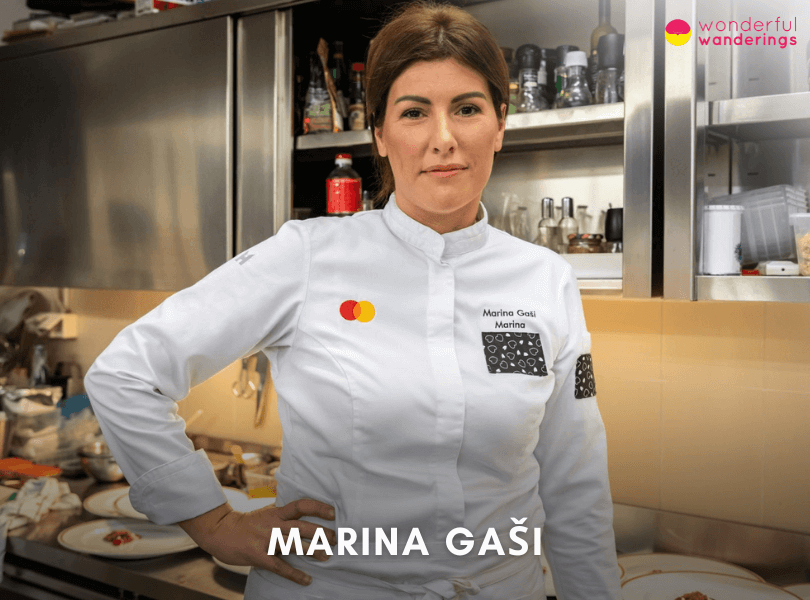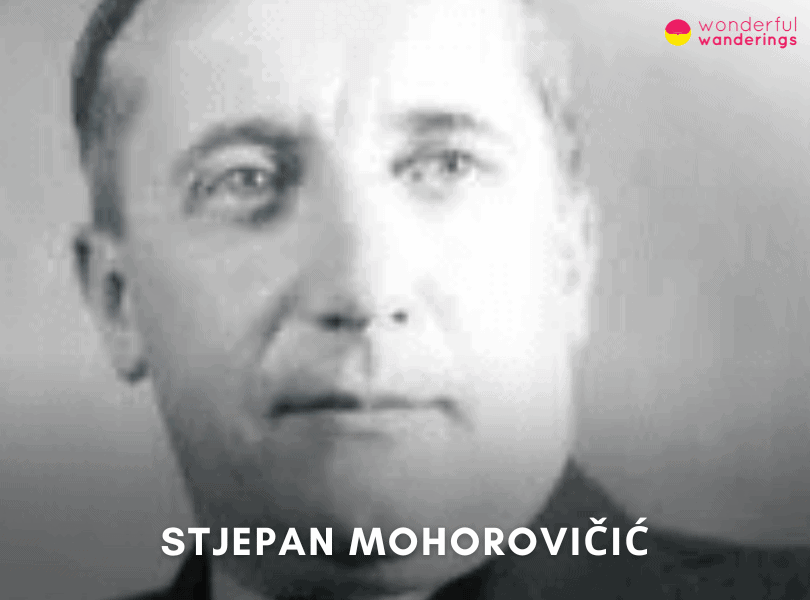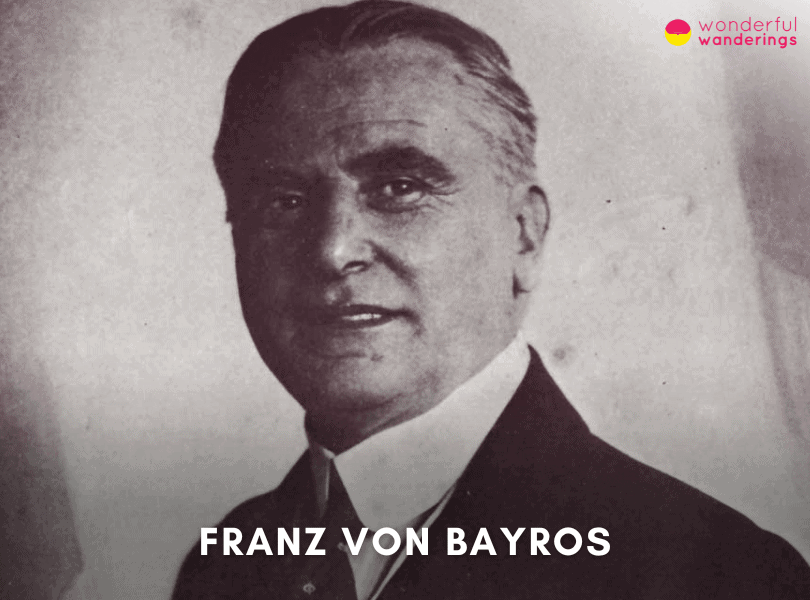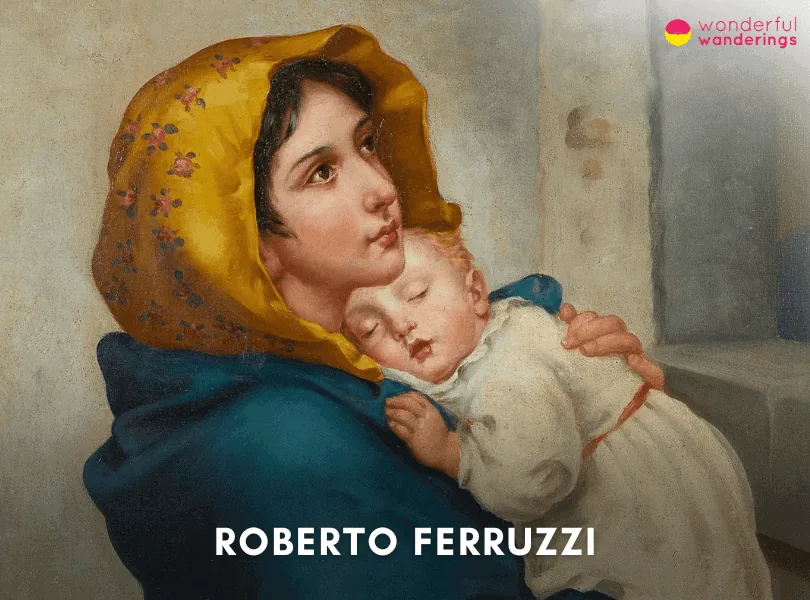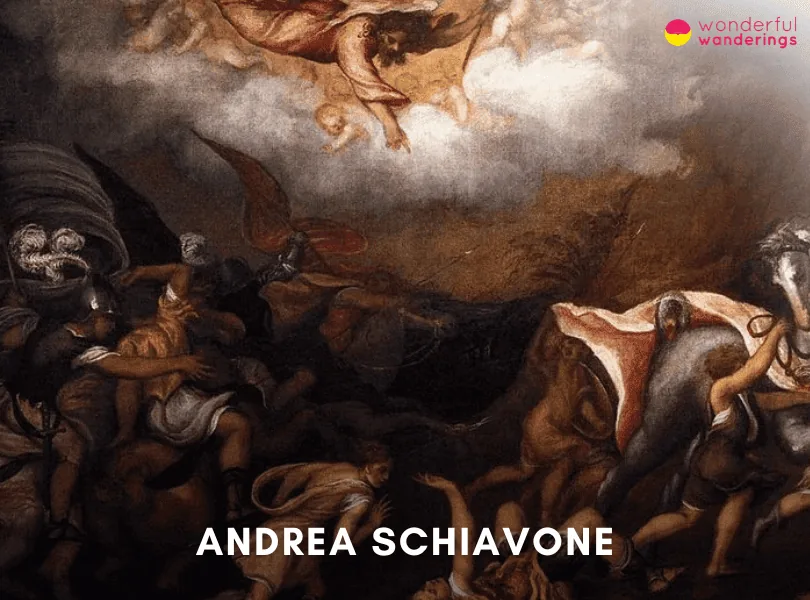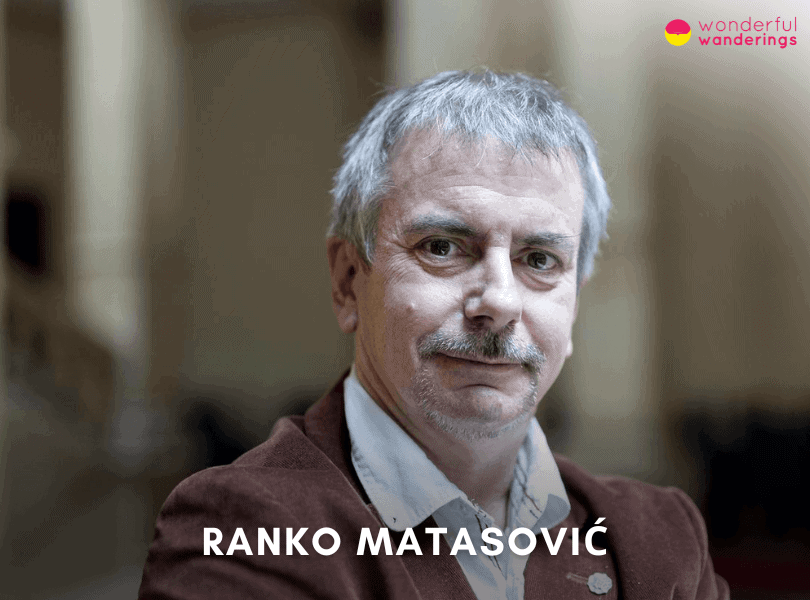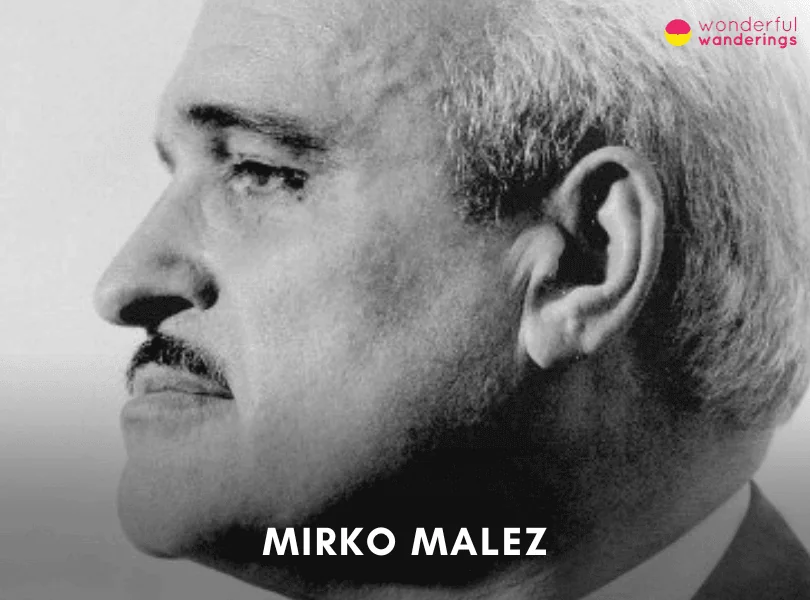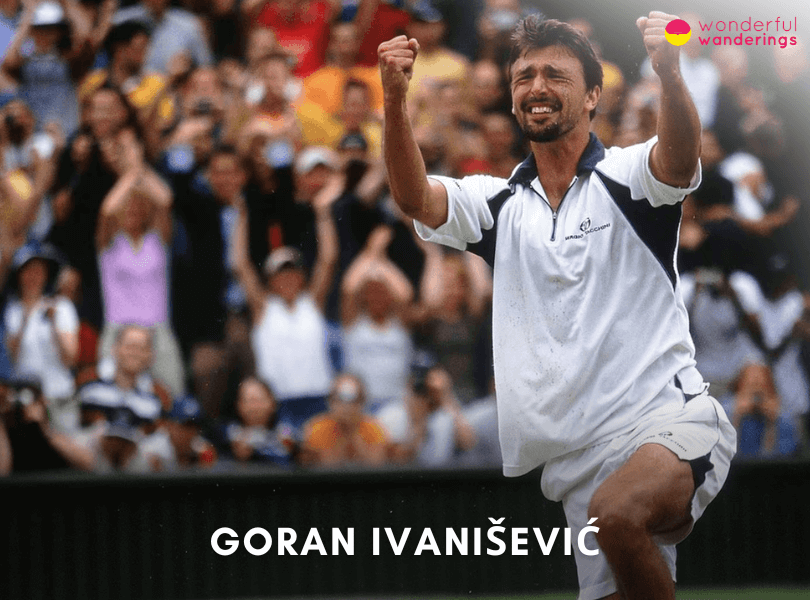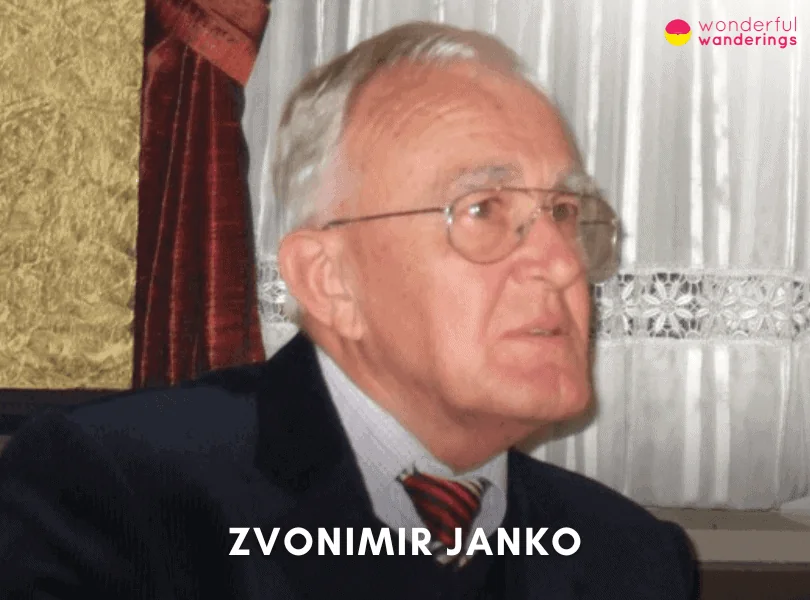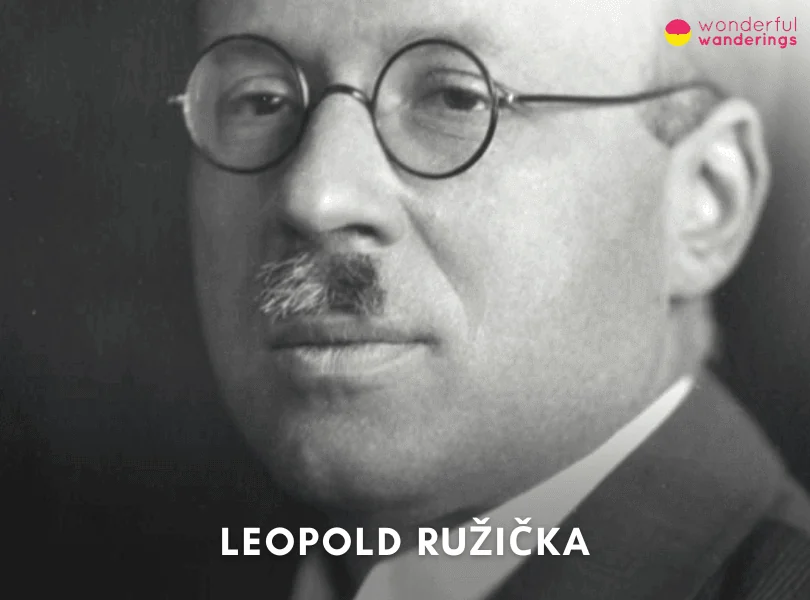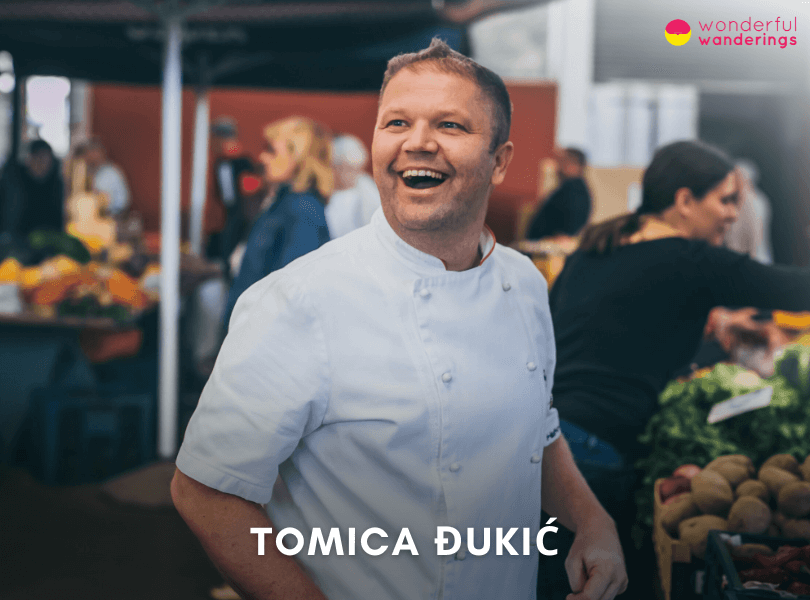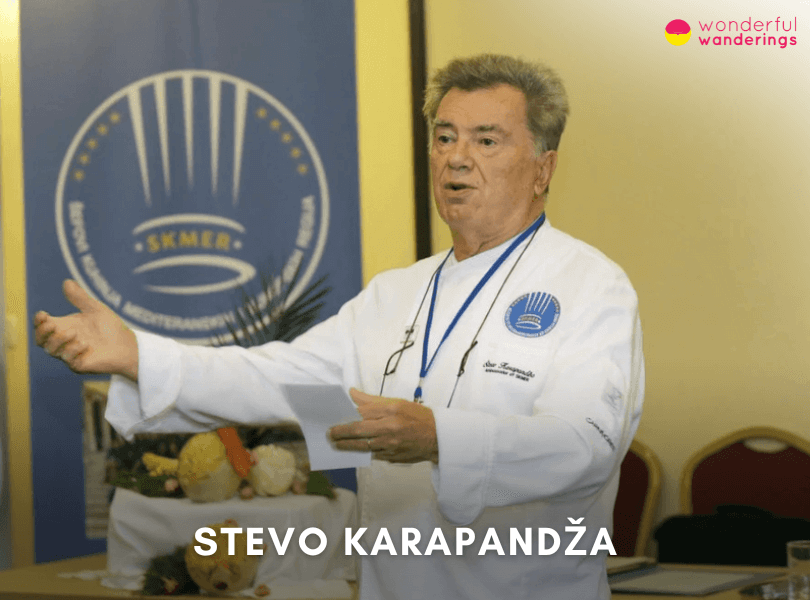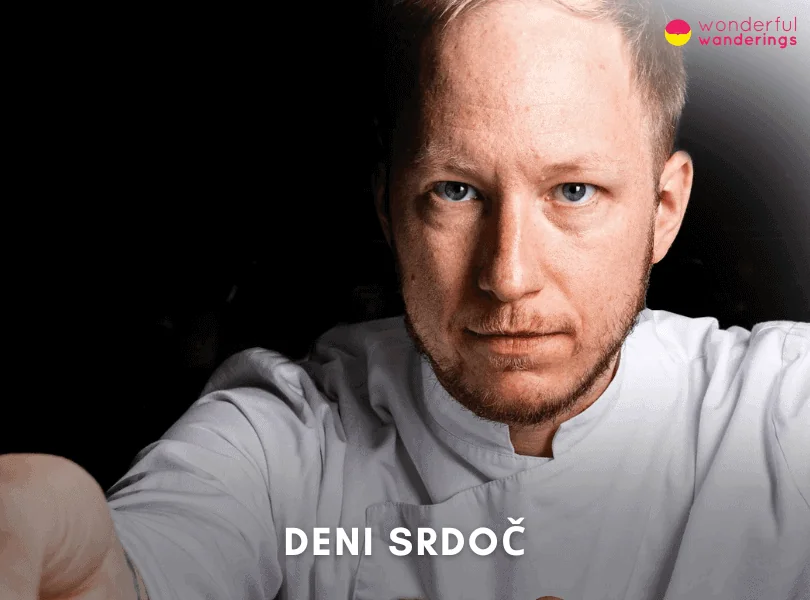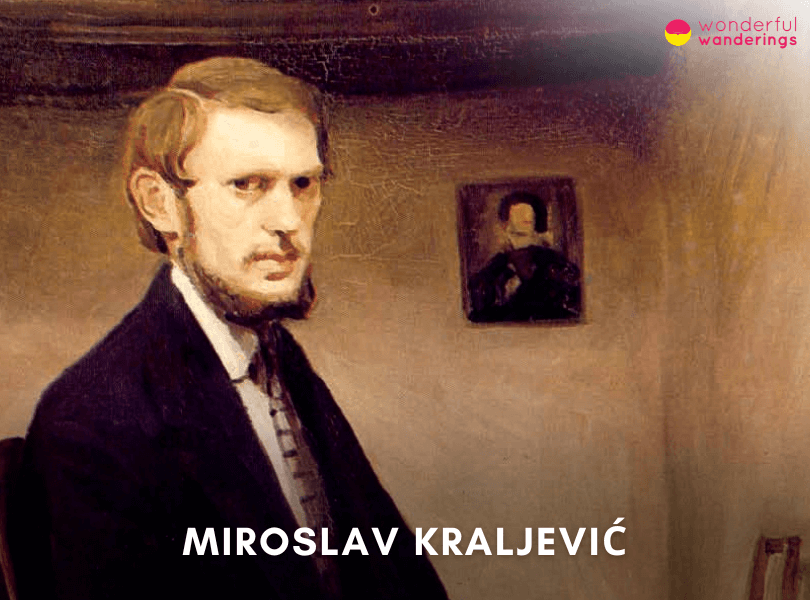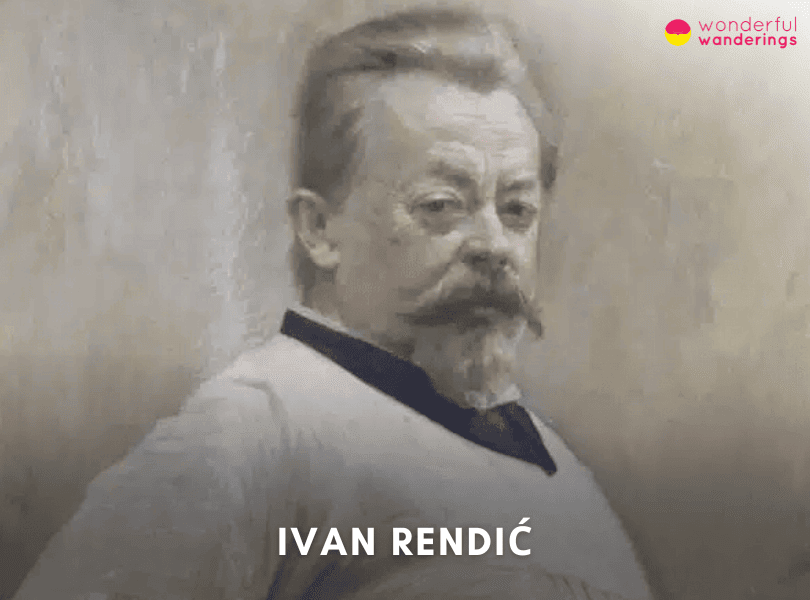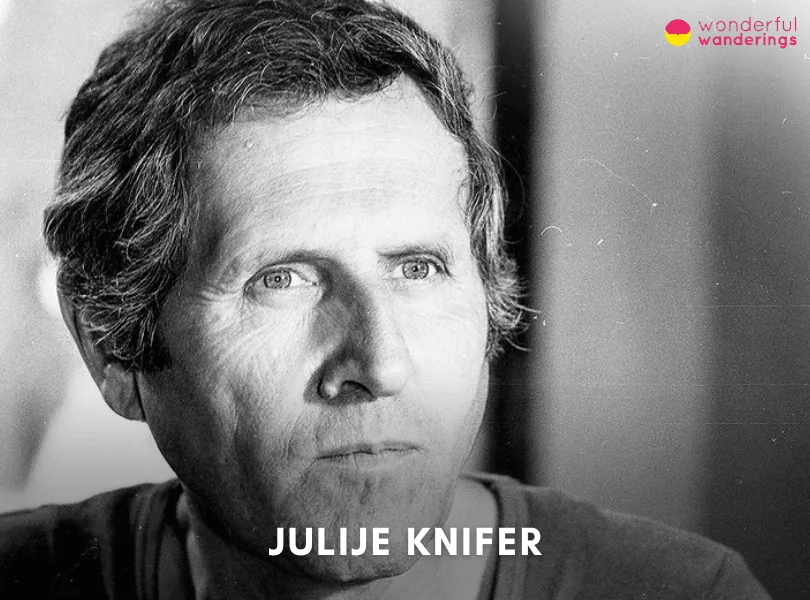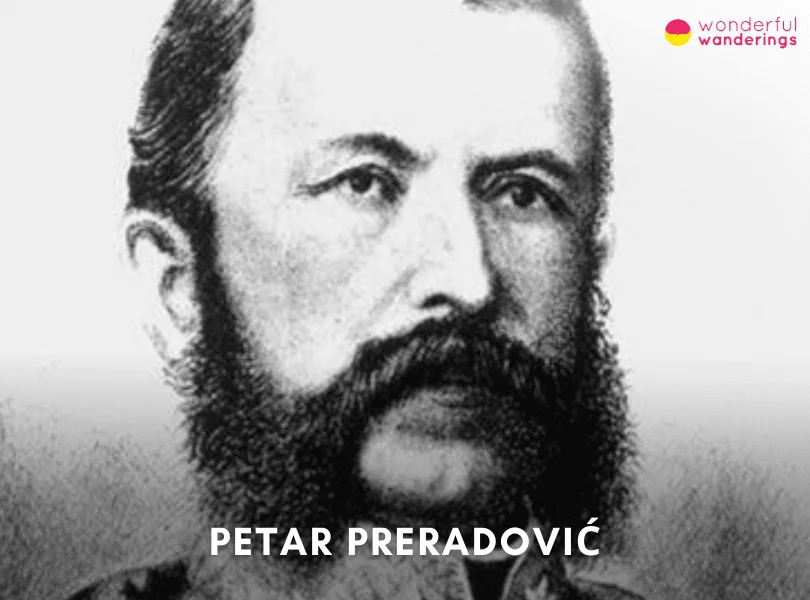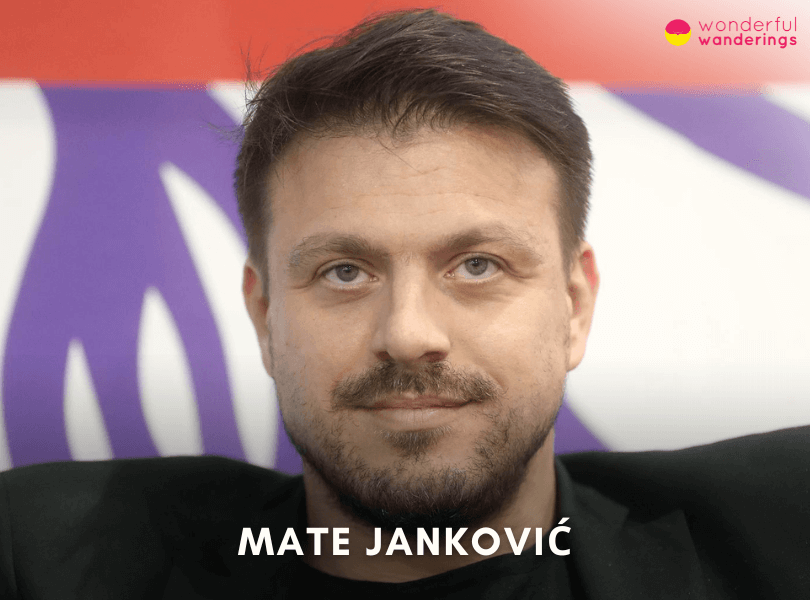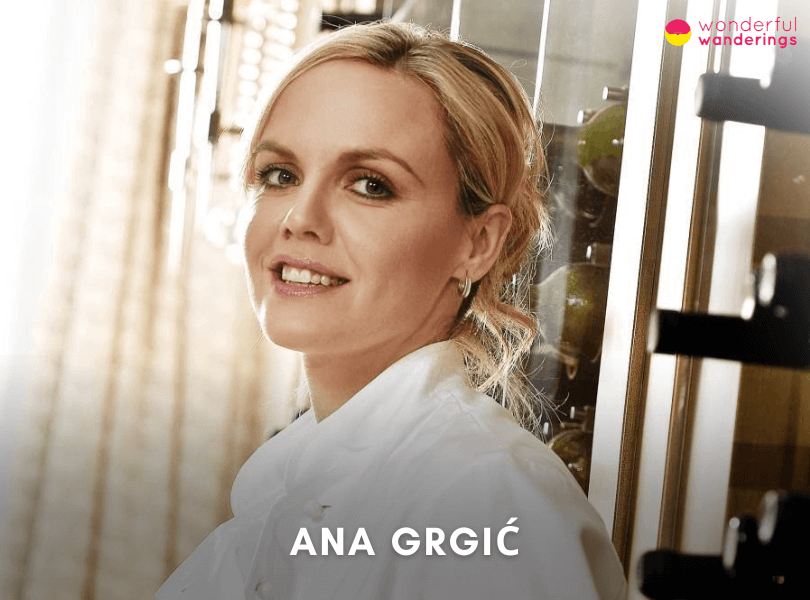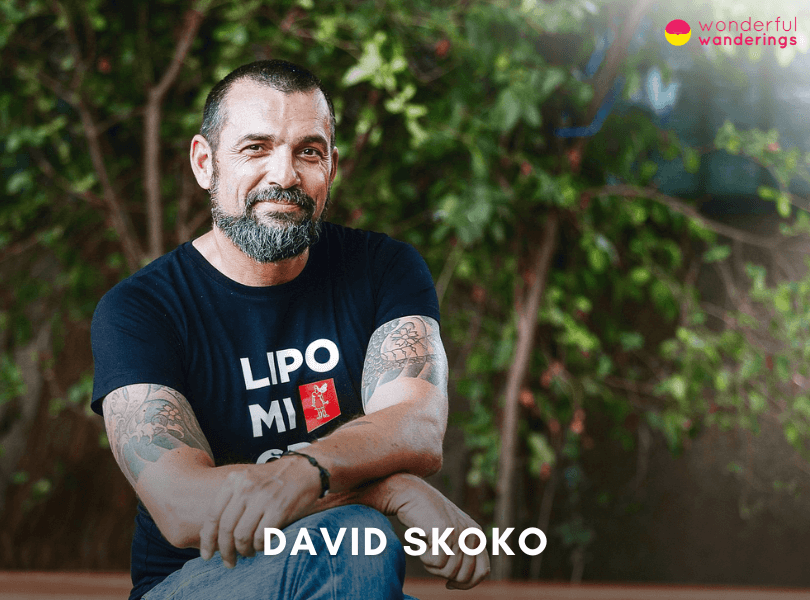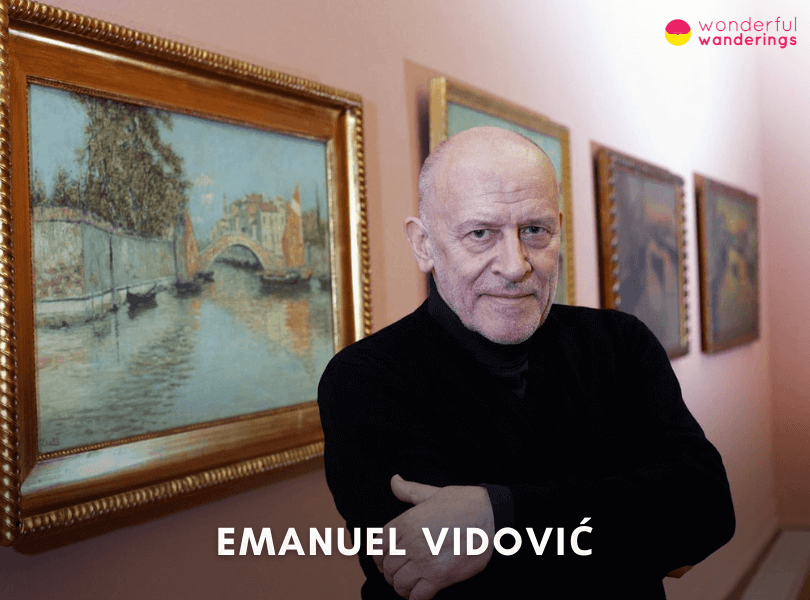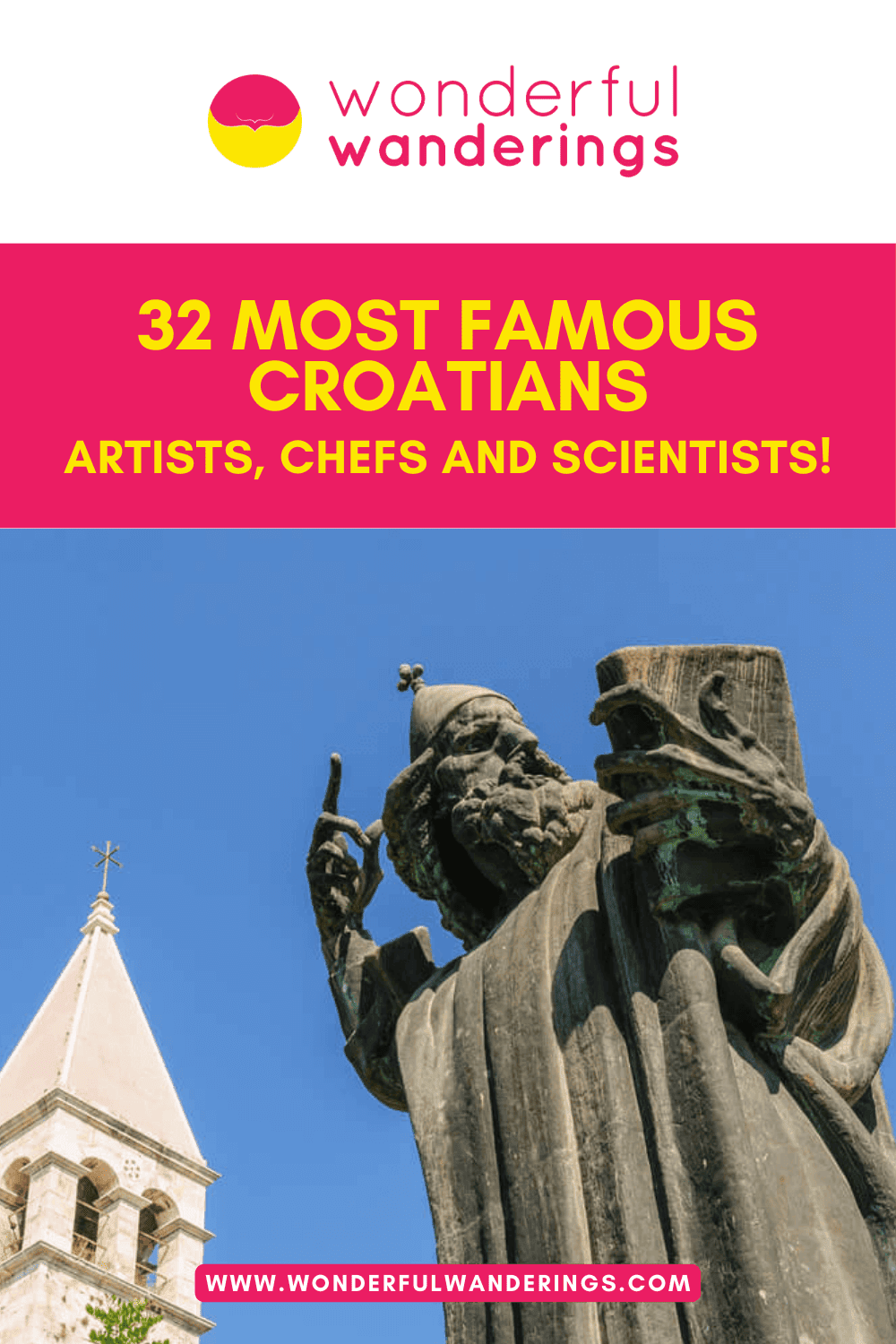Croatia is a country with a rich cultural legacy across various fields. Numerous notable Croatian artists, chefs, scientists and other luminaries have made valuable contributions that have had global impacts over the years. Croatia has been inhabited for over 8,000 years and has a rich cultural history spanning the ancient Greeks, Venetians, Ottomans and Austro-Hungarians. Key historical destinations include the medieval walled city of Dubrovnik and Europe’s oldest continuously inhabited town, Vinkovci.
Croatia features famous people who have or had made global impacts, including the inventor Nikola Tesla, sculptor Ivan Meštrović, chemist Lavoslav Ružička, film producer Branko Lustig, physicist Ruđer Bošković and economist Jakov Sirotković. Contemporary figures like performance artist Marina Abramović and tennis star Goran Ivanišević also hail from Croatia.
Listed below are the most famous Croatians.
- Nikola Tesla (1856-1943). Nikola Tesla was an electrical engineer and inventor who pioneered the development and use of alternating current (AC) electricity. His most important contribution was the creation 1895 of the first hydroelectric power plant at Niagara Falls, which used AC for long-distance transmission of electric power at 160 kilometers (100 miles). This system formed the basis for modern electric power distribution over long distances. His pioneering work with polyphase AC electricity systems established the foundation of today’s electricity-driven world.
- Ruđer Bošković (1711-1787). Ruđer Bošković was a physicist, astronomer, mathematician, philosopher and poet who made wide-ranging contributions across scientific fields. He developed an early atomic theory and “law of forces”, unifying explanations in physics made critical astronomical observations furthering understandings of planetary shapes, pioneered mathematical techniques like calculus and wrote an influential 1758 book laying the groundwork for modern physics.
- Vladimir Prelog (1906-1998). Vladimir Prelog was an organic chemist famous for establishing the importance of stereochemistry and explaining how molecules with the same formula can have different properties based on their 3D shape. His pioneering research deduced structures of complicated compounds, invented methods to assign chemical configuration and enabled syntheses of molecules like muscone. Prelog pioneered the use of techniques like NMR spectroscopy for molecular structure determination.
- Lavoslav Ružička (1887-1976). Lavoslav Ružička was a chemist who won the 1939 Nobel Prize in Chemistry for groundbreaking research on polymethylenes and terpenes that advanced understandings of complex hydrocarbons. His work elucidated the chemical structures of intricate organic molecules and enabled syntheses of key compound derivatives used commercially in fragrances or hormones. His discoveries paved the way for many subsequent advances in organic chemistry.
- Franjo Hanaman (1878-1941). Franjo Hanaman was a pioneering inventor and engineer celebrated for creating the first commercially successful lightbulb featuring a durable metallic tungsten filament in 1904. His patented bulbs with tungsten filaments produced light substantially more efficiently than preexisting carbon filament variants, enabling electric lighting with lower electricity usage. The durability and efficiency of his tungsten filament bulbs represented a major milestone in lighting history by making electric light economically feasible for broad daily use for the first time.
1. Nikola Tesla
Nikola Tesla (July 10, 1856 – January 7, 1943) was an inventor and electrical engineer who made pioneering contributions to the development of electric power and AC electricity. He is one of the most important contributors to the birth of commercial electricity and is best known for his many revolutionary developments in electromagnetism. Tesla is important because he invented the Tesla coil and transformer, created the first hydroelectric power plant at Niagara Falls and held over 300 patents for his inventions, including the AC motor and polyphase AC power distribution. His alternating current (AC) induction motor and related polyphase AC patents formed the basis of modern electric power and brought electricity to homes and businesses.
Nikola Tesla was born on July 10, 1856, in Smiljan, Croatia and died on January 7, 1943, at 86 in New York City. His biggest accomplishment was his design for the first hydroelectric power plant in Niagara Falls in 1895, which was the final victory of AC over DC and allowed for long-distance transmission of electric power at 160 kilometers (100 miles). This system forms the basis of modern electric power distribution over long distances. Tesla’s inventions were fundamental to the establishment of our modern electricity-driven world.
2. Ruđer Bošković
Ruđer Bošković (May 18, 1711 – February 13, 1787) was a prominent Jesuit priest, physicist, astronomer, mathematician, philosopher, diplomat and poet who made pioneering contributions in various scientific fields. He produced an early form of atomic theory, made important astronomical observations to determine the shapes of planets and developed mathematical procedures that were forerunners of modern calculus. Bošković is an important figure in the history of science for the breadth of his accomplishments across physics, astronomy, geodesy, architecture and other areas. He embodied the quest for knowledge and discovery of the Enlightenment polymaths. His atomic theory and cosmological speculations influenced later natural philosophers and foreshadowed modern physics.
Ruđer Bošković was born in Dubrovnik on May 18, 1711, in the Republic of Ragusa (now Croatia). He joined the Jesuits and was ordained as a priest in 1744. He studied and taught mathematics, astronomy, optics and geodesy in Rome, Milan, Paris and Vienna, publishing influential works on scientific instruments, cosmology, atomism, astronomy and architecture. His most famous accomplishment was his groundbreaking 1758 book “A Theory of Natural Philosophy,” which pioneered an early form of atomic theory and a single “law of forces” to account for static and dynamic laws in physics. He died on February 13, 1787 and his work influenced later scientists and philosophers, including Roger Joseph Boscovich.
3. Vladimir Prelog
Vladimir Prelog (July 23, 1906 – January 7, 1998) was an influential Swiss organic chemist who made pioneering contributions to the development of stereochemistry. He is considered one of the foremost European chemists of the 20th century. Prelog pioneered the groundbreaking work on determining organic molecules’ molecular structure and spatial configurations. His research explained how identical molecular formulas can represent multiple compounds with different properties based on stereochemistry. He invented methods to deduce 3D molecular structures from chemical reactions and pioneered using NMR spectroscopy for structure determination.
Vladimir Prelog was born in Sarajevo, Bosnia and Herzegovina, in 1906. He studied and worked across Europe before settling in Zürich, Switzerland in 1941. He joined ETH Zürich in 1957 and worked there until his retirement in 1975. Prelog won the 1975 Nobel Prize in Chemistry with John Cornforth for his contributions to the stereochemistry of organic molecules and reactions. This prize recognized his lifetime of work establishing the significance of stereoisomers and inventing methods to determine their structures. The “Prelog convention” for assigning stereochemical configurations is named after him and remains critically important in chemistry. He continued teaching and researching organic chemistry until he died in 1998 at 91.
4. Lavoslav Ružička
Lavoslav Ružička (September 13, 1887 – September 26, 1976) was a Croatian chemist who won the 1939 Nobel Prize in Chemistry for his work on polymethylenes and higher terpenes. Ružička is regarded as one of Croatia’s most prominent chemists for his pioneering research elucidating the structures of complex organic molecules and advancing the field of organic chemistry. His work focused on terpenes and polycyclic compounds, determining their chemical makeup and spatial configurations. Ružička enabled the synthesis of derivatives like muscone and civetone used in perfumes.
Lavoslav Ružička was born in Vukovar, Croatia, in September 1887. He studied chemistry in Zagreb, Karlsruhe and Zurich before becoming a professor at the ETH Zurich. Ružička’s biggest accomplishment was his 1939 Nobel Prize in Chemistry, awarded “for his work on polymethylenes and higher terpenes”, including the first chemical synthesis of the sex hormone androsterone. This groundbreaking research determined the structures of complicated hydrocarbon molecules and enabled the synthesis of important derivatives. Ružička published over 500 scientific papers and trained numerous students. He died in September 1976 in Mammern, Switzerland, at age 89.
5. Franjo Hanaman
Franjo Hanaman (June 30, 1878 – January 23, 1941) was a Croatian inventor, engineer and chemist who gained world recognition for inventing the first commercially viable electric lightbulb with a metal filament. He worked with his assistant Alexander Just to develop an electric lightbulb with a tungsten filament, which they patented in Hungary in 1904. Hanaman is an important figure in the history of electric lighting because his lightbulb with a tungsten filament was far more efficient and durable than existing carbon filament bulbs. The high melting point of tungsten allowed it to burn brighter while consuming less electricity. Hanaman made electric lighting much more economical and helped pave the way for the widespread adoption of electric lights in the 20th century.
Franjo Hanaman was born on June 30, 1878, in the village of Drenovci in the Kingdom of Croatia-Slavonia, which was then part of Austria-Hungary. He studied chemistry in Vienna and worked as a professor in Zagreb, Croatia. He died on January 23, 1941, in Zagreb at 62. Hanaman’s biggest accomplishment was the 1904 patenting and commercialization of his tungsten filament lightbulb, which produced light more efficiently than any prior commercially available bulb. This invention brought inexpensive electric lighting into mainstream use globally and was a milestone in lighting technology. Hanaman sold the patent rights to General Electric in 1910.
6. Ivan Meštrović
Ivan Meštrović (August 15, 1883 – January 16, 1962) was a famous Croatian sculptor, architect and writer considered one of the greatest sculptors of the 20th century. Meštrović is Croatia’s most significant modern artist. He created impactful sculptures, monuments and buildings, blending influences from ancient Greek, Renaissance and Slavic art with modern styles. His works embodied emotional power and explored themes of religion, national identity, heroism, suffering and history. Some of Meštrović’s most famous creations include the Grgur Ninski statue and Ivan Meštrović Gallery in Split, the Victor monument in Belgrade, Indians and Pioneers sculptures in Chicago and the Račić and Meštrović Mausoleum in Cavtat. He also designed several churches in Croatia and the United States.
Ivan Meštrović was born on August 15, 1883, in Slavonia. He studied at academies in Vienna and Paris, gaining recognition after exhibiting internationally in 1904. He lived and worked in Yugoslavia, Italy, Switzerland and France, settling in the United States, where he served as a university professor until his death. Meštrović’s biggest accomplishment was establishing an instantly recognizable national style of sculpture, blending modernism with ancient and Renaissance influences. He produced numerous iconic monuments, statues, reliefs and buildings celebrated in Croatia and abroad. He died in South Bend, Indiana, in 1962 at 78.
7. Vlaho Bukovac
Vlaho Bukovac (July 4, 1855 – April 23, 1922) was a famous Croatian painter and academic, one of Croatia’s most prominent modern artists during the late 19th and early 20th centuries. Bukovac is considered an important figure in Croatian art for creating diverse paintings and drawings that blended influences from Western European movements like Realism, Art Nouveau and Symbolism with Croatian cultural themes. His works frequently depicted idealized peasant scenes, biblical motifs, expressive portraits and nude studies. Many of his paintings embodied a distinctly Croatian national character.
Vlaho Bukovac was born in the village of Cavtat near Dubrovnik in 1855. He studied art in Zagreb and Vienna before moving to Paris, where he trained under famous artists and began exhibiting at the Paris Salon from 1878 onward. He later returned to Croatia and served as a professor at the Academy of Fine Arts in Prague. Bukovac’s most famous painting was his 1887 work Une Fleur (A Flower), an Impressionist-inspired painting of a nude woman holding a flower that brought him great acclaim when exhibited. The painting illustrated his mastery of European styles while retaining a symbolic Croatian meaning. Bukovac continued creating paintings until he died in Prague in 1922 at age 66. He produced a substantial catalog of nationally significant artworks.
8. Svetozar Kurepa
Svetozar Kurepa (May 25, 1929 – February 2, 2010) was an influential Croatian mathematician who made important contributions to functional analysis, operator theory and other areas. Kurepa is considered one of Croatia’s most prominent 20th-century mathematicians. He advanced the fields of functional analysis and operator theory through his research on topics like quadratic functionals, cosine functional equations and the theory of operators on Hilbert spaces. His work also encompassed mathematical physics, differential equations and geometric function theory.
Svetozar Kurepa was born in Majske Poljane, Croatia in May 25, 1929. He studied mathematics at the University of Zagreb, earning his PhD in 1958. He spent his career teaching at the University of Zagreb, serving as chair of the mathematics department and dean of the faculty. Kurepa’s most celebrated achievement was his 1958 monograph “A Theory of Natural Philosophy”, which pioneered an early form of atomic theory and a single “law of forces” unifying physics. This influential work foreshadowed modern physics and impacted later scientists. Kurepa significantly contributed to mathematics and physics until he died in Zagreb in February 2010 at age 80. He published over 70 scientific papers and 16 books, supervising over 100 graduate students.
9. Marin Soljačić
Marin Soljačić (born November 20, 1976) is a prominent Croatian-American physicist who pioneered wireless power transfer and applied electromagnetics. Soljačić is an important figure in physics and engineering for his groundbreaking work on developing mid-range wireless power transfer techniques using strongly coupled magnetic resonances. His research enabled efficient wireless electricity transmission between two coils separated by a few meters, with applications in charging electric vehicles, medical implants, phones and other devices.
Marin Soljačić was born in Zagreb, Croatia, on November 20, 1976. He studied physics at MIT, earning a PhD in physics in 2003 and has spent his career as a professor at MIT. Soljačić’s biggest accomplishment has been the realization, experimental demonstration and optimization of a mid-range wireless power transfer system based on evanescently-coupled magnetic resonators, also called “WiTricity”. This breakthrough 2007 work opened up possibilities for wireless power applications revolutionizing electromagnetics. Soljačić continues conducting research at MIT focused on applying physics to tackle global energy problems. He has published over 100 highly influential papers and earned numerous awards recognizing the importance of his innovations.
10. Ivo Šlaus
Ivo Šlaus (born September 26, 1931) is an eminent Croatian physicist and global thought leader who significantly contributed to nuclear physics, particle physics, science policy and sustainable development issues. Šlaus is important for his extensive work spearheading global initiatives on complex issues confronting humanity. He has held leadership roles in organizations like the World Academy of Art & Science, Club of Rome, European Leadership Network and Croatian Pugwash Council. He has catalyzed action on challenges like nuclear disarmament, environmental protection, poverty eradication and reforming global governance.
Ivo Šlaus was born in Split, Croatia, on September 26, 1931. He studied and worked as a professor in Zagreb before taking on international visiting academic positions at institutions like UCLA, Duke and Kyoto University. His biggest accomplishment has been providing visionary leadership and intellectual guidance to global networks of experts and policymakers aiming to address threats to human survival and progress. This includes serving as President of the World Academy of Art & Science from 2011-2013 after being one of its founding members, directing its South East European Division, editing its journal Cadmus and currently holding the position of Honorary President. Šlaus has mobilized collaborative efforts to develop solutions to safeguard humanity’s future.
11. Alfred Freddy Krupa
Alfred Freddy Krupa (born June 14, 1971) is an acclaimed Croatian multidisciplinary artist considered a pioneering force in the New Ink Art movement. He is known for his ink paintings, drawings and other works blending Western and Eastern influences. Krupa is an important figure in contemporary art for advancing and gaining recognition for the New Ink Art genre, which combines traditional Eastern ink painting with modern European styles. His spontaneous, emotionally expressive ink works on paper and canvas have brought attention to this movement and style of art internationally.
Alfred Freddy Krupa was born on June 14, 1971, in Karlovac, Croatia (then Yugoslavia). He studied painting at the Academy of Fine Arts in Zagreb, researching Eastern ink painting on a fellowship in Tokyo. His biggest accomplishment is the 1996 manifesto he authored that defined the ideas and aesthetics of New Ink Art. This seminal text helped establish the philosophical underpinnings of the movement. Krupa has created substantial paintings, drawings and other artworks exhibited and collected globally. He continues to be a leading proponent of New Ink Art.
12. Marina Gaši
Marina Gaši (born August 15, 1980) is an acclaimed Croatian chef considered one of the country’s leading culinary talents. She is the head chef and co-owner of Restaurant Marina in Novigrad, Croatia, which has earned acclaim for its creative seafood-focused tasting menus.
Gaši is regarded as an important figure in modern Croatian gastronomy for advancing a distinct style of cuisine focused on local Adriatic seafood prepared in inventive ways. Her dishes blend various influences while retaining a minimalist philosophy and emphasizing the essential flavors of pristine ingredients.
Critics have praised Marina Gaši’s ability to create an ever-changing daily menu dictated by the catch brought in by local fishermen each morning. This hyper-seasonal approach and imagination in the kitchen have brought her attention domestically and abroad. She focuses on elevating humble seafood to new heights through unexpected flavor combinations and techniques. Some of Gaši’s signature dishes include creative riffs on sea bass, monkfish, scampi, tuna and other local species prepared with soy sauce, yuzu, squid ink, fermented vegetables and Asian spices. Her tasting menus have received acclaim for their delicate construction, where no flavors overpower. Gaši was named president of the Jeunes Restaurateurs d’Europe’s Croatian chapter in 2019, recognizing her rising status in the country’s contemporary dining scene. She continues garnering praise as an inventive, self-taught chef putting her spin on Adriatic cuisine.
13. Stjepan Mohorovičić
Stjepan Mohorovičić (August 20, 1890 – February 13, 1980) was a Croatian physicist and geophysicist who made pioneering contributions in seismology, meteorology, astrophysics and theoretical physics. Mohorovičić is famous in scientific circles for his 1934 theoretical prediction of the possible existence of positronium – a bound system containing an electron and a positron. This work foreshadowed the later discovery of antimatter.
Stjepan Mohorovičić was born in Bakar, Croatia. His father was the esteemed geophysicist Andrija Mohorovičić. Stjepan studied physics in Zagreb and Göttingen. He worked as a high school teacher in Croatia and pioneered new methods in seismology that built upon his father’s research on the Earth’s interior structure.bMohorovičić’s biggest accomplishment was his 1934 paper published in the journal Astronomische Nachrichten, where he postulated the existence of positronium based on the expected interactions between an electron and a positron. This prediction was experimentally proven in 1951. The discovery of this lightweight antimatter system helped provide convincing early evidence for the validity of quantum mechanics. Though under-recognized in his time, Mohorovičić’s insight set the stage for advances at the intersection of particle physics and astrophysics.
14. Franz von Bayros
Franz von Bayros (May 28, 1866 – April 3, 1924) was an Austrian commercial artist, illustrator and painter best known for his controversial Tales at the Dressing Table portfolio featuring erotic drawings. He was a leading figure in Austria’s Decadent art movement, often utilizing sensual themes and fantastical imagery in his works. Bayros is considered an important turn-of-the-century erotic illustrator for his influential Tales at the Dressing Table, a collection of risqué drawings published in 1911 that explored sexuality and desire through his elegant graphic style. The taboo-breaking nature of these illustrations led to obscenity charges against Bayros in Munich and his exile back to Vienna.
Franz von Bayros created over 2,000 illustrations and drawings acclaimed for their delicate line work and ornate decorative elements. He illustrated classics of erotic literature and designed ex libris bookplates featuring beautiful female nudes. His drawings of femme fatales encapsulated fin de siècle Vienna’s fascination with female sexuality and feminine power. Bayros was born on May 28, 1866, in Zagreb, Croatia. As a young man, he studied art in Vienna before settling in Munich, where he first gained fame. After being exiled from Germany in 1911 due to his scandalous portfolio, he returned to Vienna, where he worked until his early death on April 3, 1924, at age 57.
15. Roberto Ferruzzi
Roberto Ferruzzi (December 16, 1853 – February 16, 1934) was an acclaimed Italian painter best known for his 1897 painting “Madonnina” (Madonna of the Streets), which gained international fame. Ferruzzi is considered an important Italian artist of the late 19th century for his skill in figure painting and his iconic “Madonnina” image depicting a young peasant girl and her brother in a tender scene evoking religious themes. This work brought him acclaim for its emotional resonance and technical mastery.
Roberto Ferruzzi was born to Italian parents in Šibenik, Dalmatia (now Croatia), in December 1853. He studied law in Padua but pursued painting, gaining recognition at exhibitions in Turin and Venice in the 1880s and 1890s. Ferruzzi’s biggest accomplishment was winning the silver medal at the 1897 Venice Biennale for his painting “Madonnina”, which popularly became known as the Madonna of the Streets. This image of a young girl cradling her baby brother took on religious connotations and was reproduced widely, bringing Ferruzzi international fame. The emotive depiction of a peasant Madonna and Child exemplified his skills and style.
Ferruzzi continued painting until he died in Venice in 1934 at 80, but the “Madonnina” remained his most acclaimed work over his career. He left a legacy as a preeminent regional Italian painter of the late 19th century.
16. Andrea Schiavone
Andrea Schiavone (c. 1510/1515 – 1563) was an Italian painter and etcher who was one of the most original artists in 16th-century Venice. He pioneered an eccentric, expressive style that blended influences from Mannerism and the Venetian Renaissance masters. Schiavone is considered an important transitional figure between the High Renaissance and the later Venetian school, represented by Tintoretto and Veronese. His works shocked some contemporaries and stimulated younger artists with vivid colors, energetic brushwork and unconventional compositions. He created a distinctive Venetian variant of Mannerism distinguished by sensuous figures in convoluted poses.
Andrea Schiavone was born in Dalmatia to a Slavic family. He was active in Venice by the 1530s after training under unknown masters. He worked in fresco, panel painting and etching, gaining recognition for mythological scenes and religious works commissioned by private patrons. His biggest accomplishment was developing an eccentric, anti-classical style that rebelled against High Renaissance harmonies. His expressive, painterly aesthetic incorporated Parmigianino’s elongation of figures, dynamic movement and spatial complexity while retaining Venetian elements of color and brushwork. Schiavone expanded the formal vocabulary of 16th-century Venetian painting through his innovative style, directly influencing Tintoretto, Veronese and Bassano. He died in Venice in 1563, at the age of 48.
17. Ranko Matasović
Ranko Matasović (born May 14, 1968) is an eminent Croatian linguist, Indo-Europeanist and Celticist known for his pioneering research on historical linguistics, language typology and Proto-Indo-European and Celtic languages. Matasović is considered the foremost Croatian authority on comparative and historical linguistics of the Indo-European language family. His prolific scholarship has advanced understanding of Proto-Indo-European morphology, Celtic etymology and phonology, Balto-Slavic accentology and other topics central to the field. His 2009 “Etymological Dictionary of Proto-Celtic” is a seminal work synthesizing current knowledge of the Celtic language family’s origins and development.
Ranko Matasović was born in May 1968 in Zagreb, Croatia. Matasović studied linguistics at the University of Zagreb, earning his PhD in 1995. After visiting scholarships abroad, he became a professor at the University of Zagreb in 1996. Matasović’s biggest accomplishment is his 2009 “Etymological Dictionary of Proto-Celtic”, one reviewer called “a monument of Celtic scholarship” for its comprehensive analysis of reconstructing Proto-Celtic lexicon and phonology. This seminal reference book on the Celtic languages advanced the field and cemented Matasović’s status as the world’s preeminent Celtic historical linguist. He continues his prolific research as a chaired professor in Zagreb while also training new generations of scholars.
18. Mirko Malez
Mirko Malez (November 5, 1924 – August 23, 1990) was a prominent Croatian paleontologist, speleologist, geo-scientist, ecologist and natural history writer who made pioneering contributions in fields like paleoanthropology, quaternary geology and speleology. Malez is considered the “father of Croatian speleology”, his extensive research was critical for advancing the understanding of human and animal evolution in Croatia’s karst caves. He elucidated the paleoclimate, ecosystems, material cultures and migration patterns of early humans and prehistoric species through meticulous stratigraphic, paleontological and archaeological documentation. His discoveries of Neanderthal remains at sites like Vindija Cave brought global attention.
Mirko Malez was born in Ivanec, Croatia, in November 1924. He studied geology and paleontology at the University of Zagreb, beginning his career in 1953 at Croatia’s Institute for Quaternary Paleontology and Geology, where he served as its first director. His biggest accomplishment was the 1974-1986 excavations of Vindija Cave, where his team uncovered over 100 Neanderthal fossil specimens, the richest late Neanderthal site in the world. This landmark discovery provided unprecedented insights into Neanderthal biology, behavior and extinction. Malez left a legacy as Croatia’s most prominent speleo-archaeologist through his prolific scholarship documenting over 1,000 caves across the Balkans. He died in Zagreb in August 1990 at age 65.
19. Goran Ivanišević
Goran Ivanišević (born September 13, 1971) is a retired Croatian professional tennis player best known for being the only person to win the Wimbledon Gentlemen’s Singles title as a wildcard in 2001. Ivanišević is considered the most successful male Croatian tennis player in history, having reached a career-high ranking of World No. 2 in 1994. He was well known for his powerful and consistent left-handed serve and is considered one of the greatest servers in tennis history.
Goran Ivanišević was born in September 1971 in Split, Croatia (then part of Yugoslavia). His career spanning 1988-2004, he won 22 ATP singles titles, including Wimbledon in 2001, after being runner-up in 1992, 1994 and 1998. His biggest accomplishment was his surprise Wimbledon victory in 2001 as a wildcard entrant while ranked World No. 125, making him the lowest-ranked player and the only wildcard male ever to win Wimbledon. His Wimbledon triumph came after three previous finals losses at the tournament and despite undergoing shoulder surgery earlier that year. It was a popular and emotional victory that captured the public’s imagination.
20. Zvonimir Janko
Zvonimir Janko (born 1932) is an eminent Croatian mathematician known for discovering four sporadic simple groups in finite group theory known as the Janko groups. Janko is considered one of the most important group theorists of the 20th century for his pioneering work uncovering new sporadic simple groups, which greatly impacted the classification of finite simple groups. His discoveries of groups like J1 and J2 advanced mathematical knowledge and disproved claims that no more sporadic groups existed.
Zvonimir Janko was born in December 1932 in Bjelovar, Croatia (then Kingdom of Yugoslavia). He studied mathematics at the University of Zagreb. After being unable to secure a university position in communist Yugoslavia for political reasons, he left for Australia in 1962, where he discovered the first Janko group, J1, in 1964. Janko’s biggest accomplishment is his 1964 discovery of the sporadic simple group J1, the first new sporadic group found since the 19th century. This groundbreaking finding using modular representation theory opened up new avenues in group theory and finite group classification. It brought him instant international recognition, led to professorships in Australia and later Germany and pioneered his illustrious career, discovering three more exceptional Janko groups.
21. Leopold Ružička
Leopold Ružička (September 13, 1887 – September 26, 1976) was a Croatian-Swiss chemist who was awarded the 1939 Nobel Prize in Chemistry along with Adolf Butenandt for his work on polymethylenes and higher terpenes. Ružička is considered an extremely important figure in organic chemistry and natural products for his pioneering research elucidating the structures of complex hydrocarbon molecules like terpenes and steroids. His groundbreaking work determining chemical constitutions and spatial configurations enabled the chemical synthesis of compounds like muscone and sex hormones.
Leopold Ružička was born in Vukovar in what is now Croatia. Ružička studied chemistry in Zagreb, Karlsruhe and Zurich. He spent most of his working life in Switzerland, becoming a Swiss citizen in 1917. Ružička’s biggest accomplishment was winning the 1939 Nobel Prize in Chemistry for his work explaining the structures of complicated organic molecules and enabling the synthesis of derivatives. The Nobel Prize recognized his research on polymethylenes and higher terpenes, including the first chemical synthesis of the sex hormone androsterone. Ružička published over 500 scientific papers and trained numerous students, impacting organic chemistry tremendously. He died at 89 in Mammern, Switzerland, in September 1976.
22. Tomica Đukić
Tomica Đukić (born August 15, 1970) is an acclaimed Croatian chef who has served as the head chef for the Croatian national football team since 2015. He is considered a leading figure in modern Croatian gastronomy. Đukić is important for advancing a distinct style of cuisine focused on local ingredients prepared creatively and promoting Croatian culinary traditions globally through his role as the national team’s chef. His dishes blend various influences while retaining a minimalist philosophy to let the essential flavors of pristine, seasonal ingredients shine. Critics have praised Đukić’s hyper-seasonal approach dictated by the daily catch brought in by local fishermen. His imagination in the kitchen and ability to elevate humble ingredients have brought him attention at home and abroad. He also aims to highlight high-quality producers of traditional Croatian products like Slavonian pork and regional wines.
Tomica Đukić was born on August 15, 1970, in Osijek, Croatia (then part of Yugoslavia). He trained professionally in Croatia, Germany and Denmark, returning to his hometown to serve as head chef at the Hotel Osijek for over 15 years. Đukić’s biggest accomplishment has been establishing his style of cuisine that blends local Slavonian and Dalmatian traditions with modern techniques and subtle global touches. His creative yet ingredient-focused cooking has garnered acclaim and cemented his status as an important figure shaping the direction of contemporary Croatian gastronomy.
23. Stevo Karapandža
Stevo Karapandža (born May 27, 1947) is a famous Croatian chef who was the first celebrity cooking show star in Yugoslavia. Along with Ivo Serdar and later Oliver Mlakar, he hosted the popular weekly TV Zagreb show “Male tajne velikih majstora kuhinje” (Little Secrets of Great Chefs), which promoted Vegeta and showcased recipes from 1974-1991. Karapandža is considered the most famous chef of former Yugoslavia for bringing cooking shows into households nationally. His charismatic on-screen presence and simple yet delicious recipes made him a recognizable figure across the Balkans. He demonstrated over 1,000 recipes from domestic and global cuisines and traveled extensively.
Stevo Karapandža was born in Gornja Trebinja near Karlovac, Croatia. Karapandža started as a chef in Zagreb’s hotels before launching his TV career. After leaving Croatia due to threats from nationalists during the Yugoslav Wars, he worked abroad before returning to open a restaurant in Lovran. Karapandža’s biggest accomplishment was pioneering televised cooking shows in Yugoslavia and essentially serving as the celebrity chef ambassador of Balkan cuisine with his long-running national program. This helped popularize cooking as a hobby and profession across former Yugoslav states. He brought joy, recipes and attention to the cuisine before today’s global celebrity chefs emerged.
24. Deni Srdoč
Deni Srdoč (born 1989) is an acclaimed Croatian chef considered one of the country’s leading culinary talents. He is the head chef and owner of the Michelin-starred restaurant Nebo in Rijeka, Croatia. Srdoč is regarded as an important figure in modern Croatian gastronomy for advancing a distinct style of cuisine focused on local Adriatic seafood prepared in inventive ways. His dishes blend various influences while retaining a minimalist philosophy and emphasizing the essential flavors of pristine ingredients. Critics have praised Srdoč’s hyper-seasonal approach dictated by the daily catch brought in by local fishermen. His imagination in the kitchen and ability to elevate humble seafood have brought him attention domestically and abroad. He showcases high-quality Croatian ingredients to their full potential through unexpected flavor combinations and techniques.
Some of Deni Srdoč’s signature dishes include creative riffs on sea bass, monkfish, scampi, tuna and other local species prepared with elements like yuzu, squid ink, fermented vegetables and Asian spices. His tasting menus have received acclaim for their delicate construction where no flavors overpower. Srdoč earned his second Michelin star for Nebo at 29 years old, cementing his status as an inventive, self-taught chef reinventing Adriatic cuisine. He continues garnering praise as a leading proponent shaping the direction of contemporary Croatian dining.
25. Miroslav Kraljević
Miroslav Kraljević (December 14, 1885 – April 16, 1913) was a Croatian painter, printmaker and sculptor who was one of the pioneers of modern art in Croatia. He is considered important as a founder of Croatian modernism for his diverse body of works across various media that blended influences from Western European movements like Realism and Art Nouveau with Croatian themes.
Miroslav Kraljević was born in Gospić, Croatia, in December 1885. He studied painting at academies in Zagreb, Munich and Paris, gaining recognition after exhibiting his works internationally starting in 1908. He produced paintings, drawings, prints and sculptures depicting peasant life, landscapes, portraits and more. His style evolved from realism to a more expressive and colorful aesthetic. Kraljević died prematurely of tuberculosis in Zagreb in April 1913 at the young age of 27, cutting short his promising career at its height. Over his short but prolific career, he produced over 200 works that helped usher Croatian art into the modern era. His self-portrait “Self Portrait with a Dog” (1910) is considered one of his most iconic paintings. Kraljević left a legacy as a founder of modernism in Croatian art who synthesized various influences into a distinctive style.
26. Ivan Rendić
Ivan Rendić (August 27, 1849 – June 29, 1932) was a famous Croatian sculptor who was one of the most prominent sculptors in Croatia during the late 19th and early 20th centuries. Rendić is the father of modern Croatian sculpture and one of Croatia’s most significant artists. He created impactful public monuments, statues and architectural works, blending influences from ancient Greek, Renaissance and Slavic art with contemporary styles. His works embodied emotional power and explored themes of national identity and history. Some of Ivan Rendić’s most famous creations include the statues of Ivan Gundulić, Petar Preradović and Josip Juraj Strossmayer at the Croatian Pantheon of Great Men in Zagreb, the monument to Duke Branimir in Zagreb and architectural works like the bell tower in Ložišća on Brač island.
Rendić was born on August 27, 1849, on the island of Brač, Croatia. He studied sculpture in Venice, Florence and Vienna, gaining recognition after exhibitions started in the 1870s. He lived and worked in Zagreb, Vienna and Trieste, creating over 200 statues and monuments throughout his career. Rendić’s biggest accomplishment was establishing modern Croatian sculpture through his expressive, lyrical style, blending contemporary and historical influences. His public monuments and statues symbolized Croatian cultural identity and cemented his legacy as the father of Croatian sculpture. He died in Split, Croatia, in 1932 at 82.
27. Julije Knifer
Julije Knifer (April 23, 1924 – December 7, 2004) was an acclaimed Croatian abstract painter and a founding member of the Gorgona Group, an avant-garde collective active in Zagreb during the 1960s. Knifer is considered a leading figure in 20th-century Croatian art for his lifelong exploration of a single geometric motif – the meander. His minimalist paintings, drawings, prints and sculptures focused almost exclusively on interlocking right-angle patterns, reducing painting to its essence. He exhibited internationally and his works blended influences from Russian Suprematists like Malevich with Conceptual tendencies.
Julije Knifer was born in April 1924 in Osijek, Croatia (then Kingdom of Yugoslavia). He studied painting in Zagreb, where he co-founded Gorgona in 1959. He participated in the pioneering New Tendencies movement of the 1960s before gaining recognition for his meander-based abstractions. His biggest accomplishment was creating his first meander works around 1960, which became the central motif he would explore for the rest of his 40-year career through various techniques and scales. This lifelong dedication to investigating the possibilities of a simple form through endless variations established his iconic visual language. Knifer had cemented his legacy as one of Croatia’s most famous.
28. Petar Preradović
Petar Preradović (March 19, 1818 – August 18, 1872) was a famous Croatian poet, military officer and general considered one of Croatia’s most important Romantic poets of the 19th century. Preradović is important for his patriotic poetry promoting Croatian national consciousness and identity during the Illyrian movement and Austrian Empire rule. His works spoke of Croatian political aspirations and evoked themes of national mythology. He systematically wrote poetry in the Croatian vernacular, advocating using Gaj’s Latin script in southern Croatia.
Petar Preradović was born in Grabrovnica near Pitomača in northern Croatia. Preradović enrolled in military academies in Vienna and Graz, pursuing a military career across the Empire while writing poetry. He took part in the 1848 Hungarian Revolution. His famous works included the 1844 song “Zora puca, bit će dana” (Dawn Breaks, The Day is Coming). Preradović’s biggest accomplishment was his seminal role as a leader of the mid-19th century Illyrian movement that stimulated Croatian national awakening through his poetry and advocacy. He produced extensive patriotic poetic works that exemplified Romantic nationalism, promoting Croatian culture, identity and language. Preradović died in Vienna in 1872 at the age of 54.
29. Mate Janković
Mate Janković (born on March 12, 1975) is an acclaimed Croatian chef who has gained recognition as a judge on MasterChef Croatia, author of cookbooks showcasing Croatian cuisine and through his restaurants, including his tapas bar SOL. Janković is considered an important figure in modern Croatian gastronomy for advancing and promoting local cuisine through his books, media appearances and restaurants. His 2011 “Croatia. The Cookbook” compiled recipes from top chefs across Croatia’s regions, bringing attention to the country’s culinary traditions.
Mate Janković has over 20 years of experience as a professional chef. He has worked at major hotels and launched his restaurants. Janković’s biggest accomplishment is authoring the seminal cookbook “Croatia. The Cookbook” in 2011, which The Wall Street Journal called “the definitive book on Croatian cuisine” for its comprehensive coverage of regional specialties. This book boosted interest in Croatian food worldwide. Janković continues to promote local cuisine as a TV personality, chef and restaurateur based in Zagreb.
30. Ana Grgić
Ana Grgić (born February 11, 1990) is an up-and-coming young Croatian chef making a name for herself on the international culinary scene. She is important in modern Croatian cuisine for promoting Croatian gastronomy globally through her acclaimed restaurant Lexington Brindle in London. Ana was born in February 1990 in Zadar, Croatia. Her biggest accomplishment so far has been earning a Michelin star in 2021 for Lexington Brindle within just 16 months of opening, making her the first female Croatian chef to achieve this prestigious honor. She gained experience at famous restaurants like Claridge’s and The Connaught before opening Lexington Brindle’s restaurant in late 2019.
Lexington Brindle draws inspiration from Ana Grgić’s Croatian heritage and British location to create inventive tasting menus that fuse the two culinary styles. The rapid Michelin star recognition brought Ana’s creative blend of Croatian traditions with British ingredients into the spotlight. Ana Grgić represents an exciting new generation of young Croatian chefs sharing the quality and diversity of Croatian gastronomy with the world.
31. David Skoko
David Skoko (born January 10, 1976) is an acclaimed Croatian chef considered a leading figure in modern Croatian gastronomy. He is the owner and head chef of Restaurant Batelina in Banjole, Croatia, which has earned acclaim for its creative, seasonal seafood dishes.
David Skoko is regarded as an important chef for advancing a distinct style of cuisine focused on local Adriatic seafood prepared in inventive ways that blend various influences while retaining a minimalist philosophy. His hyper-seasonal tasting menus dictated by the daily catch have brought him attention both domestically and abroad. Critics have praised Skoko’s ability to create an ever-changing menu showcasing unexpected preparations of pristine seafood brought in by local fishermen. He emphasizes elevating humble ingredients to new heights through creative flavor combinations and techniques.
David Skoko was born on January 10, 1976, in Pula, Croatia (then Yugoslavia). He started working in Restaurant Batelina, which his parents opened in 2000, taking over as head chef. Skoko’s biggest accomplishment has been earning two Michelin stars for Restaurant Batelina and cementing its status as one of Croatia’s top fine dining destinations. His inventive, ingredient-focused cuisine and lifelong promotion of local seafood and traditions through his restaurants, cookbooks and TV appearances have garnered him international acclaim.
32. Emanuel Vidović
Emanuel Vidović (June 17, 1870 – June 1, 1953) was a famous Croatian painter who pioneered modern art in Croatia in the early 20th century. He is key in introducing modern styles like Expressionism, Fauvism and Cubism to Croatian painting. Vidović is important because his diverse works across various styles and media spearheaded the development of modernist painting in Croatia. He brought back avant-garde ideas like abstraction, distorted perspective and unnatural colors from his travels. He incorporated them into landscapes, portraits, nudes and genre scenes with Croatian themes that modernized Croatian art.
Emanuel Vidović was born in Split in June 1870 and died in Zagreb in June 1953 at 83. He trained at academies in Vienna, Munich, Paris and Zagreb, gaining recognition after exhibitions of his works blending post-Impressionism and Expressionism starting in 1910. Vidović’s biggest accomplishment was pioneering modern styles and subjects in Croatian art in the early 1900s before they gained wider acceptance. His progressive approach to depicting Croatian themes set the stage for other artists to adopt modernist techniques. The diversity of his stylistic innovations left a legacy and he is remembered as the father of 20th-century Croatian painting.
Who are the most famous Croatian scientists and inventors?
Listed below are the most famous Croatian scientists and inventors.
- Nikola Tesla (1856-1943). Nikola Tesla was an electrical engineer and inventor who pioneered modern electricity through groundbreaking inventions and science in alternating current motors, generators, wireless communications and remote control technology. His patents formed today’s commercial electricity system, bringing power to homes and businesses.
- Ruđer Bošković (1711-1787). Ruder Bošković was a physicist, astronomer and polymath who produced pioneering theories and insights in various scientific fields like optics, cosmology, astronomy and atomic theory through his influential 1758 work “Theoria Philosophiae Naturalis” which attempted to derive explanations for physical laws using science. His ideas explored new concepts that would influence later generations of physicists and philosophers.
- Lavoslav Ružička (1887-1976). Lavoslav Ružička was an organic chemist whose scientific research determined the molecular structures of complicated hydrocarbons, explaining how molecules with identical formulas could have vastly different properties based on their spatial configurations. This enabled the chemical synthesis of derivatives. This groundbreaking research won him the 1939 Nobel Prize in Chemistry.
- Slavoljub Eduard Penkala (1871-1922). Slavoljub Eduard Penkala was an inventor and engineer whose inventions, like the first solid-ink fountain pen in 1907, brought practical science-based innovations to wide adoption globally, revolutionizing writing technology. He also developed an innovative early thermos flask called the “Termofor” in 1903, among over 80 patented inventions.
- Franjo Hanaman (1878-1941). Franjo Hanaman was a Croatian engineer and chemist whose 1904 patented chemical science and research invention produced the tungsten filament light bulb, making electric lighting affordable to the masses. This milestone invention brought inexpensive electric light powered by science and technology.
Who are the most famous Croatians who hold a special record?
Listed below are the most famous Croatians who hold a special record.
- Nikola Tesla (1856-1943). Nikola Tesla was an inventor and engineer who pioneered modern alternating-current electricity through groundbreaking patents and innovations in motors, generators and transmission. His 300+ patents formed the foundation of today’s electricity system that brings power to homes and businesses via extensive AC networks. Tesla also developed early wireless communications and remote control technology ahead of his time. His science-based inventions directly contributed to the electrification that shapes the modern world.
- Lavoslav Ružička (1887-1976). Lavoslav Ružička was a Croatian chemist whose research on the structures of complicated hydrocarbon molecules won him the 1939 Nobel Prize in Chemistry for the chemical synthesis of polymethylenes. His work revolutionized the field of organic chemistry by determining how molecules with identical formulas could have vastly different properties based on their spatial configurations, enabling the synthesis of derivatives.
- Ivan Meštrović (1883-1962). Ivan Meštrović was an internationally famous Croatian sculptor considered among the greats, creating over 1000 expressive statues, monuments and buildings fusing Renaissance, Baroque, Art Nouveau, Cubist and modern influences. His iconic works, like the Grgur Ninski statue in Split, brought him global fame for their fluid forms and emotive power, earning comparisons to Michelangelo.
- Branko Lustig (1932-2019). Branko Lustig was the only filmmaker from the former Yugoslavia to win two Academy Awards, recognizing his producer role on the acclaimed Holocaust drama “Schindler’s List” (1994) and historical epic “Gladiator” (2001). He survived Auschwitz as a child and worked on major Hollywood blockbusters for decades, including titles like “The Peacemaker” (1997) and “Black Hawk Down” (2001), before he died in 2019. Lustig brought unprecedented filmmaking honors to Croatia.
Who are the most famous Croatian artists?
Listed below are the most famous Croatian artists.
- Ivan Meštrović (1883-1962). Ivan Meštrović was an acclaimed Croatian sculptor and architect known for his expressive bronze and stone sculptures exploring themes like religion, history and nationalism. Some of his most famous works include the Grgur Ninski statue and Ivan Meštrović Gallery in Split and monuments in Belgrade, Chicago and other cities. Over his long career, Meštrović created impactful sculptures, monuments and buildings that embodied emotional power and national identity, earning him international recognition. He is remembered as one of Croatia’s most significant modern artists.
- Emanuel Vidović (1870-1953). Emanuel Vidović was a Croatian painter who pioneered modern art styles like Expressionism and Cubism in Croatia in the early 20th century. He introduced avant-garde techniques to Croatian painting through his progressive depictions of landscapes, portraits, nudes and genre scenes with Croatian themes. Vidović’s diverse body of works spearheaded the development of modernist painting in Croatia and set the stage for other Croatian artists to adopt modern styles. He is considered the father of 20th-century Croatian painting for modernizing art in his home country and synthesizing various Western influences into a distinctive style.
- Vlaho Bukovac (1855-1922). Vlaho Bukovac was a prominent Croatian painter around 1900 who blended various influences into his works. He explored Croatian cultural themes through idealized peasant scenes, emotive portraits, symbolic nudes and other subjects. He served as a professor at the Academy of Fine Arts in Prague and was a leading figure in Croatia’s art scene at the turn of the 20th century. Bokuvac left a substantial body of paintings and drawings that illustrated his stylistic range over his prolific career.
- Julije Knifer (1924-2004). Julije Knifer was a founding member of the avant-garde Gorgona Group, active in Zagreb during the 1960s. She was Croatia’s most famous modern abstract artist, known almost exclusively for his minimalist “meander” motif. He prolifically explored this single geometric form across paintings, reliefs, works on paper and other mediums over his 40+ year career.
- Miroslav Kraljević (1885-1913). Miroslav Kraljević is a pioneering modern Croatian painter and printmaker who spearheaded Croatian modernism before 1913. He introduced progressive styles to Croatian art through expressive, colorful landscapes, portraits and genre scenes. He studied and exhibited both domestically and abroad, gaining recognition before dying prematurely of tuberculosis at 27. Kraljević produced over 200 works, helping usher Croatian art into the modern era and leaving a legacy as Croatian modernism’s founder.
Who are the most famous Croatian singers and musicians?
Listed below are the most famous Croatian singers and musicians.
- Tereza Kesovija (born 1938). Tereza Kesovija is known as the “Croatian Edith Piaf” due to her emotive vocals. She rose to fame in the 1960s with songs like “Million Scarlet Roses”. Kesovija represented Monaco at Eurovision in 1966 and Yugoslavia in 1972. She has released over 30 albums, performed in sold-out concerts worldwide and received many honors, including the Vladimir Nazor Award for Life Achievement. Kesovija continues to record and perform live into her late 70s.
- Neda Ukraden (born 1946). Neda Ukraden is a popular pop and folk singer in former Yugoslavia. Her best-known songs include “The Balkan Soul”, “I Have Only One Love”, and “I Leave You a Song”. Ukraden survived a terrible car accident in 1969 that threatened her career but made an impressive comeback. She has released over 25 albums and has undertaken many international tours. Ukraden is admired for overcoming adversity and continuing to entertain audiences after 50 years.
- Arsen Dedić (1938- 2015). Arsen Dedić was a prolific singer-songwriter who penned over 1500 songs in various genres. He had great success with romantic songs like “July in Dubrovnik” and “A Man and a Boat”. Dedić composed for many artists contributed to over 40 movie scores and published several poetry collections. He received significant recognition, including Porin for Lifetime Achievement and the Vladimir Nazor Award. Dedić left an immense musical legacy when he passed away in 2015.
- Vice Vukov (1936-2008). Vice Vukov was a popular pop and rock singer from the 1960s to the early 2000s across ex-Yugoslavia. He performed hits like “Ča Ima Zagreb” and “Blue Sea” in famous venues like the Split Festival. Vukov won many accolades, including the Porin Award and the Croatian Radio Festival Prize. He acted in movies alongside singing and worked as a musician abroad. Vukov made a huge impact in his prime but faded from the limelight over personal struggles later.
- Severina (born 1972). Severina is currently Croatia’s most prominent pop singer and entertainer. She achieved breakout fame by winning the prestigious Dora contest in 2006. Severina has released chart-topping dance-pop albums like “Dobrodošao u klub” and “Zdravo Marijo”. She caused controversy with her personal life and provocative music videos. Severina remains popular in the Balkans through touring, TV appearances and social media. She continues to make catchy pop hits after 20 years in the business.
Who are the most famous Croatian actors?
Croatia has several famous actors. John Malkovich is an acclaimed American actor known for roles in films like Dangerous Liaisons, In the Line of Fire and Being John Malkovich. He has been nominated for two Academy Awards and won numerous other awards. His paternal grandparents were Croatian immigrants from Ozalj. Malkovich has been involved in fashion design and co-founded the clothing line Mrs. Mudd. He has also directed several films and plays. Rade Šerbedžija is a prolific Croatian actor who has appeared in over 100 films in Croatia and internationally. Some of his most acclaimed roles were in films like Downtime, Before the Rain, The Saint and Harry Potter and the Deathly Hallows. In addition to acting, he is an accomplished musician and poet who has published several books. Šerbedžija has received lifetime achievement awards at film festivals in Pula and Cairo for his extensive work. Mira Furlan was a Croatian actress who succeeded in Yugoslav cinema before emigrating to the U.S. in 1991 during the Croatian War of Independence. She acted in American films and TV shows like Babylon 5, Lost, NCIS. Los Angeles and Westworld. Furlan won several awards for acting in Yugoslavia and posthumously received the Vladimir Nazor Award, Croatia’s highest artistic honor. She was an activist for Croatian independence and human rights.
Who are the most famous Croatian sportsmen?
Listed below are the most famous Croatian sportsmen.
- Janica Kostelić (born 1982). Janica Kostelić is a former World Cup alpine ski racer from Croatia. She won four World Cup titles, three Olympic gold medals and five World Championship gold medals. Her 30 individual World Cup race wins make her the most successful Croatian Winter Olympic athlete. Kostelić has received many awards, including being named Croatian Sportswoman of the Year seven times. She is the only woman to win three alpine skiing gold medals in one Olympics.
- Dražen Petrović (1964-1993). Dražen Petrović was a Croatian professional basketball player who played for the New Jersey Nets and the Croatian national team. He earned the nickname “Mozart of Basketball” for his abilities on the court. Tragically, he died in an automobile accident at age 28, at the peak of his career. Petrović has posthumously received many honors, with several buildings and monuments named after him in Croatia. His legacy continues to inspire young Croatian basketball players today.
- Ivana Brkljačić (born 1964). Ivana Brkljačić is a free-diver from Croatia who holds multiple Guinness World Records related to the sport. She holds the record for a female’s deepest dive without fins, reaching 72 meters (236 feet) in 2016. Brkljačić previously held the overall record at 73 meters (239 feet). She broke her record for longest underwater breath hold in 2018 while swimming horizontally, achieving 150 meters in a single breath. She is known as the “Croatia Mermaid”, and promotes the protection of the oceans.
- Sandro Mur (born 1970). Sandro Mur was a Croatian singer who holds the Guinness World Record for the lowest vocal note by a male. He reached G-7.5707 in 2000, the lowest note a human voice can phonate. Mur’s extraordinarily deep voice was likely related to his impressive stature at 6 feet 9 inches tall. He used his rare talent to portray monsters and creatures in films with his unnervingly deep vocalizations. Mur passed away in 2010, but his record-setting vocal abilities remain legendary.
- Janica Kostelić (born 1982). Janica Kostelic is a former World Cup alpine ski racer from Croatia. She won four World Cup titles, three Olympic gold medals and five World Championship gold medals. Her 30 individual World Cup race wins make her the most successful Croatian Winter Olympic athlete. Kostelić has received many awards, including being named Croatian Sportswoman of the Year seven times. She is the only woman to win three alpine skiing gold medals in one Olympics.
- Stipe Božić (born 1979). Stipe Božić (born 1979) is a strongman and powerlifter from Croatia best known for towing the most massive aircraft ever pulled by a man. In 2013, Božić towed a US Air Force C-130H aircraft weighing over 61 metric tons a distance of 8.8 meters (28.87 feet). This set a new Guinness World Record, shattering the previous record by over 27 metric tons. Božić achieved this incredible feat by harnessing power through his entire body, not just arms. He continues to compete in strongman competitions and amazing crowds with his extreme strength.
Who are the most famous Croatian chefs?
Listed below are the most famous Croatian chefs.
- Ana Grgić (born 1982). Ana Grgić is an acclaimed young chef pioneering modern Croatian cuisine in Zagreb at her restaurants Boogie and Fotić. Before returning to Croatia, she trained under famous chefs and their restaurants, like Daniel Boulud in New York and Michel Roux in London. Grgić uses seasonal local ingredients to create innovative dishes based on Croatian traditions. She has been featured in international culinary magazines and named a rising star chef by publications like Fine Dining Lovers. Grgić also promotes Croatian cuisine through appearances at food festivals globally.
- Mate Janković (born 1975). Mate Janković is a celebrated Croatian chef known for his contemporary, ingredient-focused take on Dalmatian cuisine. He runs several restaurants in Croatia that have won international acclaim, including Bevanda and Batelina. Janković modernizes classic regional dishes using cooking techniques he learned from working under famous European chefs. He is considered a pioneer of modern Croatian cuisine and has appeared on TV shows demonstrating his creative recipes. Janković also founded the culinary festival NoBevanda to showcase Croatian food and wine.
- David Skoko (born 1984). David Skoko is an acclaimed chef known for earning a Michelin star at his restaurant 360o showcasing modern Istrian cuisine. He trained in famous European restaurants after graduating from a top Zagreb culinary school. Skoko is considered a rising star in Croatia for his classically grounded yet innovative cooking using regional ingredients. He sources Istrian olive oils, cheeses, seafood and produce to create elevated renditions of Croatian dishes. Skoko also shares his recipes and techniques through cookbooks and educational initiatives.
- Marinko Markešić (born 1978). Marinko Markešić runs the Michelin-starred restaurant Noel in Zagreb, known for progressive French-influenced cuisine. He trained under famous chefs in France and the UK before returning to open Noel. Markešić is considered one of Croatia’s top chefs for his precise, technically complex cooking and unique presentation. He incorporates regional ingredients into contemporary dishes that reference classic French techniques. Markešić strives to educate other chefs and promote Croatian cuisine’s inclusion in the international fine-dining world.
- Ivan Pažanin (born 1982). Ivan Pažanin is an acclaimed chef and owner of the Michelin-recommended restaurant Apetit City in Croatia’s Istria region. After training across Europe, he returned to create a contemporary bistro focusing on simple, seasonal Istrian cuisine. Pažanin works closely with local farmers and fishermen to source top regional ingredients to build his frequently changing seasonal menus. Food critics have praised him as one of Croatia’s rising culinary stars reinventing native cuisine using modern techniques and global inspiration.
What are the most fun facts about Croatia?
Listed below are the most fun facts about Croatia.
- Croatia has over 1,300 islands and islets along its Adriatic Coast. Croatia has over 1,300 islands and islets along its Adriatic Coast, stretching from the Istrian peninsula to Montenegro. The islands have high biodiversity, with over 7,000 identified plant and animal species, including endangered loggerhead sea turtles and monk seals. Tourism focused on the islands’ natural beauty and historic towns is important to the regional economy. The Kornati Islands National Park helps protect this unique island ecosystem. The islands have been inhabited since ancient times.
- World’s Largest Truffle Was Once in Istria, Croatia. The world’s largest truffle, weighing 1.31 kilograms (2.8 pounds), was found in Istria, Croatia, in 1999 by famous truffle hunter Giancarlo Zigante. White truffles are rare and expensive, valued for their intense flavor and aroma. The previous record truffle found by Zigante sold for €4,594 ($5,000, £3,938), but the 2014 Italian record-breaker was sold at €56,290 ($61,250, £48,254), in an auction, showing giant truffles’ culinary status. Truffles grow underground in symbiosis with certain trees and must be unearthed by experts and truffle-hunting dogs. This giant fungus crowned Italy as the truffle-hunting destination.
- 10% of Croatia’s Land Area Is Protected Parks/Reserves. 10% of Croatia’s land area consists of protected natural areas, including eight national parks that showcase mountains, lakes and forests. These conservation areas harbor many rare and endangered Croatian species, from lynx to sea turtles. Sustainable tourism centered on Croatia’s hiking brings economic benefits to rural areas and incentives to continue conservation. Croatia’s ecological network is the core of regional biodiversity protection.
- Filming Location for Game of Thrones’ King’s Landing. Dubrovnik, Croatia, was the main filming location used to represent King’s Landing in Game of Thrones. Dubrovnik’s medieval walled Old Town, Gothic architecture, cobblestone streets and proximity to the sea were ideal stand-ins. Many iconic scenes were filmed along the city walls, inside landmarks like churches and palaces and in the harbor, which was converted into the Blackwater Bay battle set.
Is it expensive to visit Croatia?
Yes, Croatia is considered a moderately expensive destination compared to other European countries. Costs and prices in Croatia can vary greatly depending on the travel style, time of year and the specific regions. For an average mid-range traveler, daily costs in Croatia are €88 ($100, £75) to €88 ($150, £112) per person when accounting for lodging, food, attractions, transportation and other common expenses. Hotel rates average €70 ($78, £60) to €132 ($146, £114) per night, higher in popular areas like Dubrovnik. Apartments, villas and private rooms provide savings over hotels. Peak summer lodging rates are 50-100% higher. Food costs are reasonable, with most restaurant meals under €18 ($20, £15). Groceries from markets average €4 ($5, £3) to €13 ($15, £11) per day. There are ways for budget-conscious travelers to visit affordably. The keys are visiting in shoulder or off-peak seasons, opting for alternative accommodations over higher-priced hotels, using public transportation to get around and limiting expensive tourist activities.
What are the most popular holiday dates in Croatia?
The most popular holiday dates in Croatia are New Year’s Day (Nova Godina on January 1st), Epiphany (Sveta tri kralja on January 6th), Statehood Day and Corpus Christi (Dan državnosti and Tijelovo on May 30th) and Christmas Day (Božić on December 25th). Firstly, New Year’s Day (Nova Godina) is celebrated on January 1st. New Year’s Day is a popular public holiday in Croatia. It is a day of joyous celebration, marked by fireworks, parties and various cultural events. Many people also attend church services to seek blessings for the upcoming year. Secondly, Epiphany (Sveta tri kralja) is celebrated on January 6th. Epiphany is a Christian feast day that commemorates the revelation of God incarnate as Jesus Christ. In Croatia, this day is marked by religious observances, including church services and blessings of water. It is also a time for family gatherings and traditional customs. Thirdly, Statehood Day and Corpus Christi (Dan državnosti and Tijelovo) are celebrated on May 30th, commemorating the establishment of the first modern multi-party Croatian Parliament in 1990. Official ceremonies, flag-raising and cultural events mark it. Corpus Christi is a religious holiday that includes processions, church services and the traditional blessing of bread and salt. Lastly, Christmas Day (Božić), celebrated on December 25th, is a major Christian holiday in Croatia. It is a time for religious observances, festive meals and the exchange of gifts. Many attend midnight Mass on Christmas Eve and participate in traditional customs and caroling throughout the holiday.
What are the top places to visit in Croatia?
Listed below are the top places to visit in Croatia.
- Zagreb. Zagreb is Croatia’s capital and stands out as a historical and cultural hub. It is known for its rich history, beginning as a free royal town in the 13th century. The Zagreb Cathedral, St. Mark’s Church and the Museum of Broken Relationships are key attractions. Zagreb enjoys a continental climate, making spring and fall ideal for visits. Zagreb requires at least a three days visit to explore its attractions and it is considered one of the top places to visit in Croatia.
- Split. Split is the second-largest city in Croatia and is celebrated for its ancient Roman heritage, particularly Diocletian’s Palace. The city is known for its old town, the cathedral, Saint Domnius and Marjan Hill. The best visitation period is late spring to early June. A three-day stay is ideal for a comprehensive exploration.
- Rijeka. Rijeka is Croatia’s third-largest city and is a significant port and industrial center. Its history spans centuries, including periods under the Byzantine Empire and Austro-Hungarian rule. Attractions include Trsat Castle and St. Vitus Cathedral and experiences a moderate maritime climate. The city can be fully experienced in 1-2 days.
- Osijek. Osijek is the largest city in Croatia’s Slavonia region. It is notable for its baroque architecture and historical significance, particularly under Ottoman and Austro-Hungarian rule. Its main attractions include Tvrđa, St. Michael’s Church and the Drava River promenade. The city’s climate is continental and a 3-5-day visit is recommended.
- Slavonski Brod. Slavonski Brod is on the Sava River in Croatia. It is an important cultural and economic center in Slavonia. The city, with a history dating back to Roman times, features attractions like the Brod Fortress and the Franciscan Monastery. The best visitation period is May to September, with 1-2 days sufficient for exploration.
PIN FOR LATER
Find below our top guides about Croatia.

